
Quadrum hosts artist reatreat!


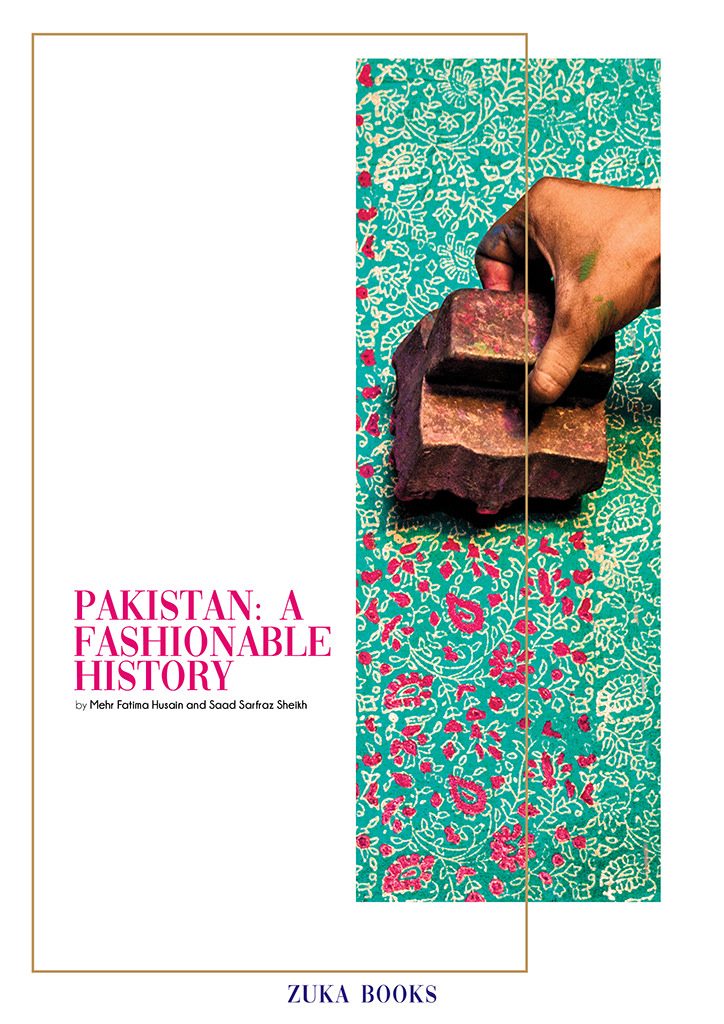
Journalist Duo Releases Book On The Fascinating History of Pakistan’s Fashion Industry!
Lahore,
Pakistan – August, 2020: Pakistan’s first-ever
non-fiction book on the creation of the local fashion industry, is the
brainchild of writer/journalist Mehr F Husain and, a collaboration with the
photojournalist, Saad Sarfraz Sheikh.
A fascinating study of the pioneers of
Pakistani fashion who came together to form what today stands as a
multi-million dollar market, Husain and Sheikh’s gorgeous coffee table book –
which took over two years to document and compile is now available for
purchase!
Filled with first person narratives from the
trailblazing designers and non-designers, fascinating anecdotes, stunning
photography and historical archives, the publication delves into the heart of
Pakistan’s history. Starting from partition, the book documents the journey of
a people who sought to dress and adorn a new country, giving the Pakistani
nation a multi-faceted identity that has remained unexplored…till now.
Husain and Sheikh’s book goes beyond the
aesthetics by gently uncovering a history, heritage and culture, and exposing
the hidden beauty of a country and its people who have been maligned and
misunderstood for far too long.
Highlighting the origins and the journey of
local fashion – amid tumultuous phases over the decades – the book is a
delicious page-turner which will appeal to a number of age groups intrigued by
the role of fashion and how socio-political issues and the quest for a young
nation’s identity led it to where it is today; a formidable force in the global
arena of fashion.
Team
Mehr Fatima Husain – Author
Mehr is a British-Pakistani journalist
based in Lahore.
Born in London, she was raised in Saudi Arabia, Pakistan
and England.
Having completed her education (secondary and undergraduate) in London, she
wound up working for Barclays in the city, ran a humour blog while based in
Saudi and over the past 12 years, and worked in different roles in the
Pakistani media industry; as a Features Editor at The Friday Times (TFT), an Assistant
Editor at Good Times (GT) magazine and as a columnist for India’s Mail Today
where her column ‘The Lahore Log’ also appeared in The Daily Mail/MailOnline.
Mehr’s commentary, criticism and journalism
have appeared in The Economist’s 1843, The Times of London,
The Diplomat, India’s Mail
Today, The Daily Mail/MailOnline, Libas, The Friday Times, Herald, Pakistan
Today, The News, The Nation and Pakistan Link. She was also the Editor for ‘Multan: A Spiritual Legacy’ (a book about ancient
structures in Multan) which was presented to HM
Queen Elizabeth by the Pakistani Ambassador to the UK in 2013. In 2014, her short
story ‘A fool’s paradise’ was published as part of an anthology that was launched
at the Karachi Literature Festival and is now part of the Pakistani national
curriculum. In 2016, another short story ‘The first cut’ appeared in another
anthology published by Mongrel Books in Karachi.
Mehr holds a MSc. in Asian Politics from
SOAS, University of London and a BSc. in Politics with Business
Management (Hons.) from Queen Mary, University
of London. She was also
accepted into an MPhil in South Asian Studies at St. Edmunds College, Cambridge. In addition,
she has delivered workshops on journalism at the prestigious Lahore University
of Management Sciences (LUMS), appeared as a guest on the hit satirical
programme ‘News, Views and Confused’ and performed as the opening act for
‘Auratnaak’, Pakistan’s first all-female comedian troupe.
Saad Sarfraz Sheikh – Photographer
Saad is an independent journalist and
photographer based in Lahore.
His journalistic career began by working as a Desk Editor for leading
newspapers in Pakistan,
including the Daily Times and The Friday Times. His work involved reporting,
writing, editing and supervising layouts of the newspapers. This led him down
the exciting path of field reporting and photography assignments for Getty
Images, Demotix and Corbis, as well as other renowned publications.
Saad’s work has been featured in Time, Al
Jazeera, Esquire (Middle East), Foreign Policy, Courrier International
(France), Pulitzer Centre on Crisis Reporting, Roads & Kingdoms, Forbes
Lifestyle (part of Forbes.com), The Hindu, Vogue India, Verve India, NowThis,
The Friday Times, Herald (Dawn), The Nation and The News on Sunday.
Apart from his prolific career, he has also
conducted photojournalism workshops at festivals and journalism institutes in Pakistan,
including a TEDx talk on photography as a medium in 2013.
Over the years, Saad has carved a name for
himself as a well-known Pakistani photojournalist, documenting issues of
conflict, politics and social issues, including local art and culture. Apart
from his journalism-related projects, Saad also shot the production stills for
two critically-acclaimed Pakistani films, ‘Shah’ and the ‘Motorcycle Girl,’
including the production of a poignant documentary for the Justice Project
Pakistan (JPP) on the plight of juveniles facing the death penalty in Pakistan.
He is also a band member of Pakistan’s only percussion band, Quadrum, and
has performed at more than 500 concerts in Pakistan and abroad. Saad has an
undergraduate degree in journalism from the Forman Christian College (FCC) in Lahore and an MA in Global Journalism from the University of Sheffield.
For press queries and further information,
please contact us at:
Email: fashionpakistan.pr@gmail.com
For VICE. Text By Sabrina Toppa, All photos by Saad Sarfraz Sheikh.
Nida Kirmani, a 40-year-old academic based in the Pakistani city of Lahore, still remembers being able to cross the border to neighbouring India with some routine questions and a wave through. Before 2017, Kirmani would make regular trips back and forth between the South Asian countries, visiting family members and friends and conducting research in Delhi.
With a Pakistani father and an Indian mother, Kirmani never felt compelled to choose between the countries, and – unusual post-1947, when the two nations gained independence from the British – Kirmani carried national ID cards from both. However, two years ago, on a return trip from Dharamshala, an Indian border officer tried to force her to surrender her Indian identity card, insisting that she had to choose. Despite the official’s attempt to sever Kirmani’s ties to India, she chose to maintain them.
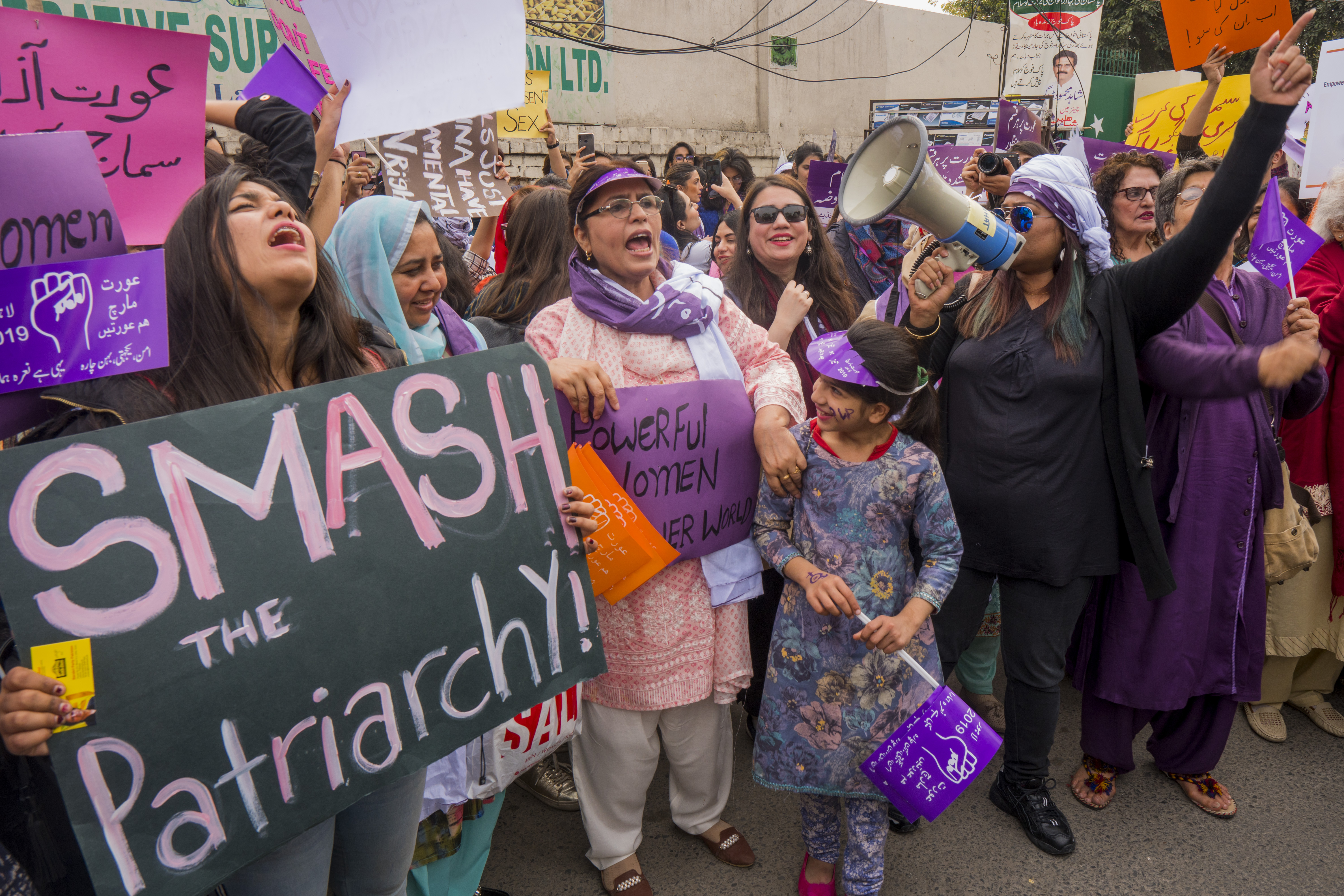
Recent events, however, have reminded the academic that not everyone feels the same way she does. Two weeks ago, over 40 Indian soldiers in the disputed territory of Kashmir – claimed by both India and Pakistan – were killed by a suicide bomber. Jaish-e-Mohammed, a Pakistan-based terror group, claimed responsibility for the attack, and the event set off a series of aircraft, artillery and naval exchanges between India and Pakistan that threaten to bring the nuclear-armed rivals to another war. As both governments seemed eager to rush towards conflict, Kirmani was annoyed, but not surprised. “I have lived and worked in both India and Pakistan, and have connections in both,” Kirmani tells me. “This has helped me see through some of the divisive rhetoric that is so pervasive on both sides of the border.”
Kirmani rejects the rabid patriotism on display from both countries. “As a feminist, I am very critical of nationalism in general, as it is often premised on the control of women’s bodies,” Kirmani says.
With this International Women’s Day falling during a period of high tension between India and Pakistan, anti-war themes have become a prominent part of the IWD marches throughout the country. Kirmani and other Pakistani women have gathered nationwide to celebrate women’s rights in Pakistan and demand access to public spaces for women and transgender people; the end to gender-based violence and discrimination; improved labour rights for women; the inclusion of women with disabilities; greater reproductive justice; and an end to police brutality. To that, the organisers have added a call for an end to India-Pakistan tensions, violence in Kashmir and the hyper-nationalism that drives wars. Among the largest events are a series of marches organised in Pakistan’s largest cities – the Aurat March (Women’s March) and Aurat Azadi March(Women’s Liberation March”).
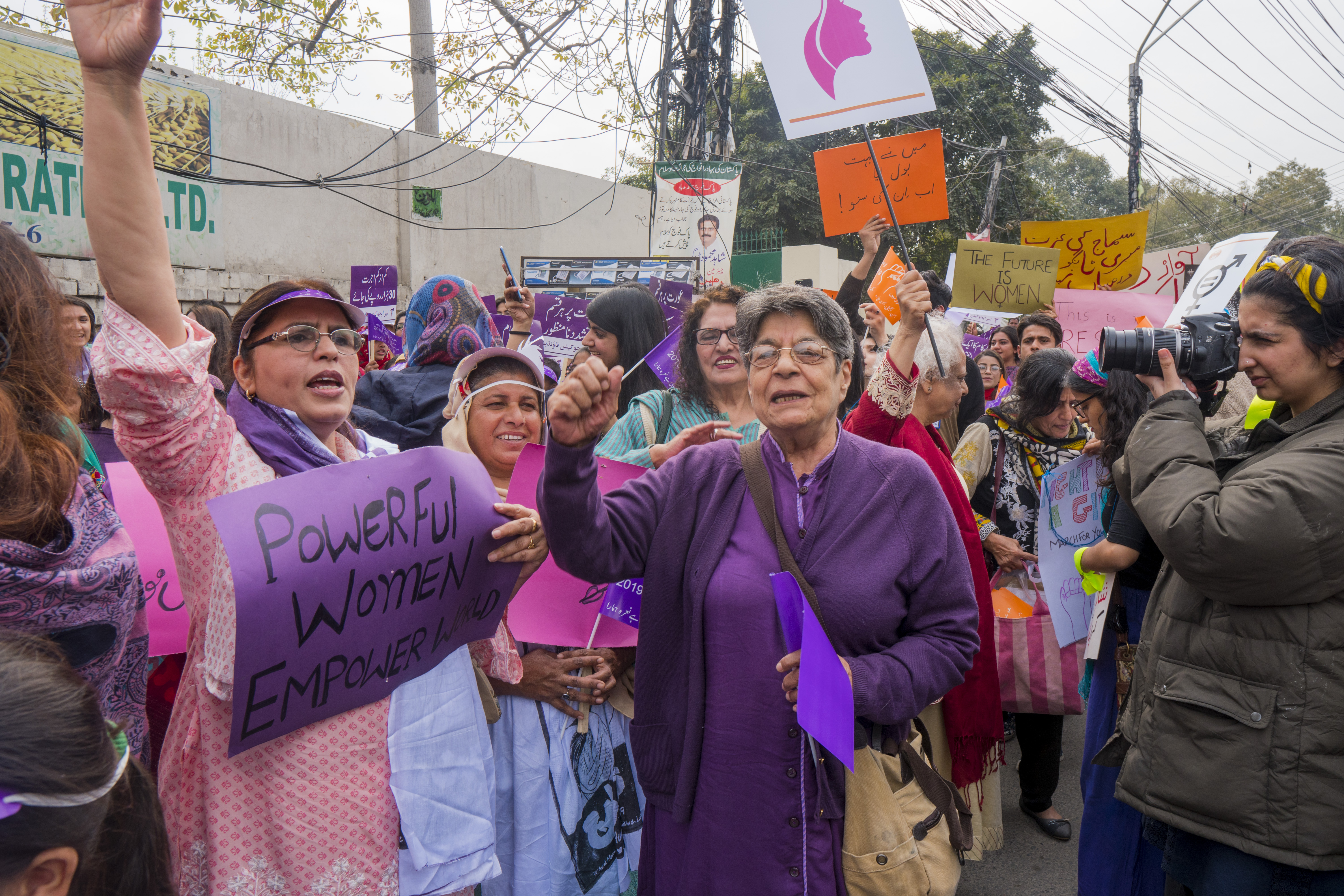
“Given the current political climate we’re in, we felt that it was important to include a feminist opposition to war in our set of demands,” says Shmyla Khan, one of the Aurat March’s organisers in Lahore. “Given that men are much more likely to fight wars, we have seen that women are often left to pick up the pieces.”
This has been true since the creation of India and Pakistan in 1947, when the violence that accompanied the Partition of British India involved the brutal rape and abduction of women on both sides. “I definitely think women no longer want war because of the intergenerational trauma women faced during Partition,” says Tooba Syed, one of the attendees of the Aurat Azadi March in Islamabad, and a political worker for the left-wing Awami Workers Party. “We remember what happened to our mothers during Partition. How can women of this region ask for war when we know our bodies are the battlefields in wars and our lives the ruins left behind?”
Sehyr Mirza, a peace activist attending Lahore’s Aurat March, still remembers stories her grandmother – who migrated from Jaipur to Lahore during Partition – told her of women carrying poison as a desperate suicide measure to avoid rape and abduction. Violence perpetrated on women during Partition is well-documented in South Asian literature and pop culture, ranging from Saadat Hasan Manto’s “Khol Do” to Rajinder Singh Bedi’s “Lajwanti”, says Mirza. Such violence replayed itself during the 1971 war between India and Pakistan, and has also been part of the current conflict in Kashmir. “As a feminist and peace activist, I believe that we must learn from our past and head towards a better future,” Mirza says. “Wars can only benefit vested political agendas and the arms industry.”
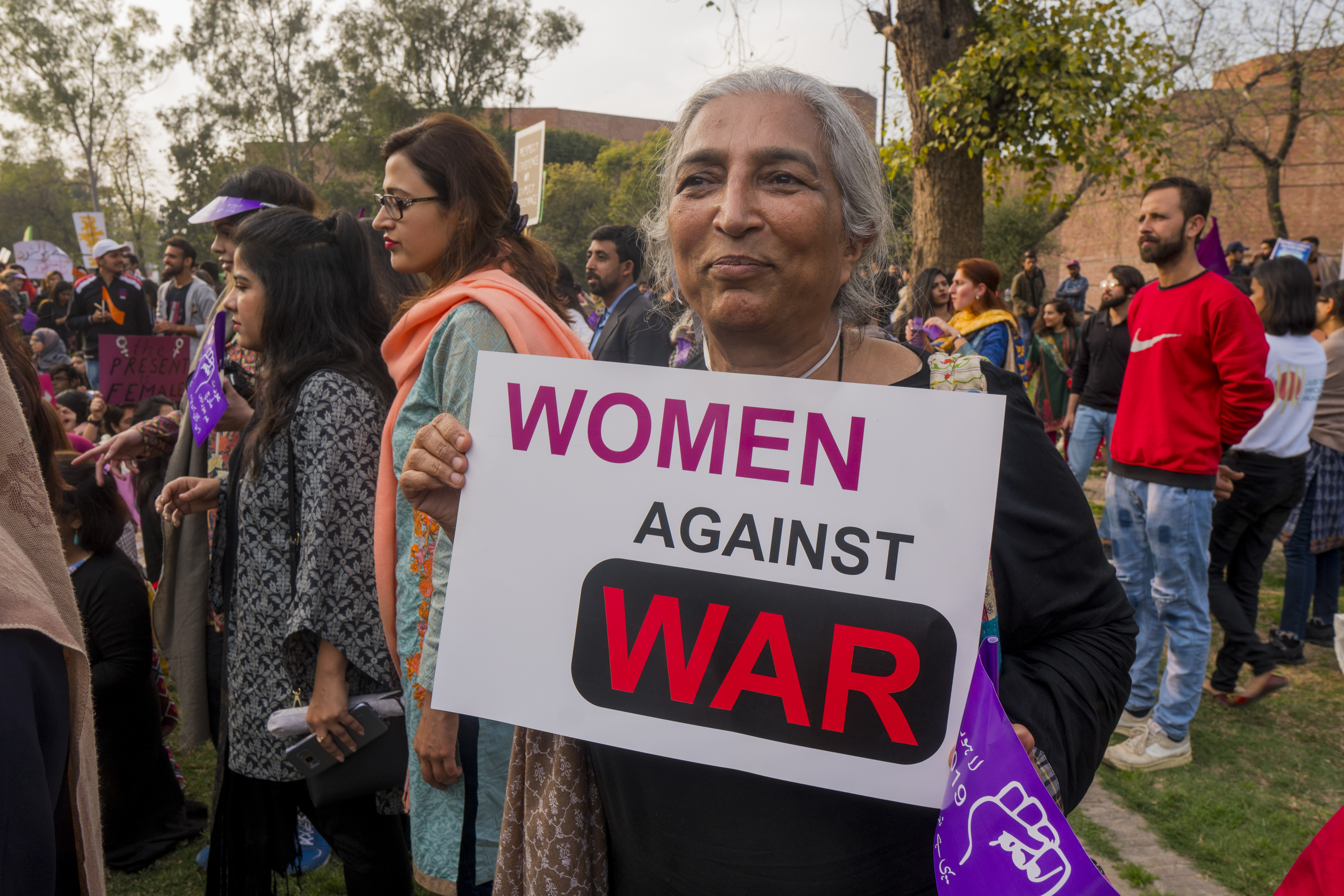
The anti-war stance was not initially meant to be a fundamental principle of Friday’s marches. Instead, the marches were intended to highlight the status of women’s reproductive, economic and legal rights in the country of more than 200 million. Women face discriminatory laws in inheritance, marriage and divorce, on top of being vulnerable to violence from regular social practices such as honour killings and acid attacks in Pakistan. Women also lag behind in education and employment opportunities. Indeed, the country’s education crisis disproportionately affects girls, with the majority of Pakistan’s 22 million out-of-school children being female, and Pakistan having one of the lowest rates of female labour market participation in the world.
After the February suicide bombing, Mirza, the Lahore-based peace activist, started the hashtag #AntiHateChallenge in Pakistan to denounce the terrorism. She posted a picture of herself holding a sign reading, “I am a Pakistani and I condemn Pulwama terrorist attack. #AntiHateChallenge #NoToWar.” Other Pakistani women followed suit, posting pictures on social media of themselves carrying identical signs. Although the backlash was nearly immediate, Mirza was happy to send a different message from her government, which had gone the route of categorically denying any culpability for the attack.
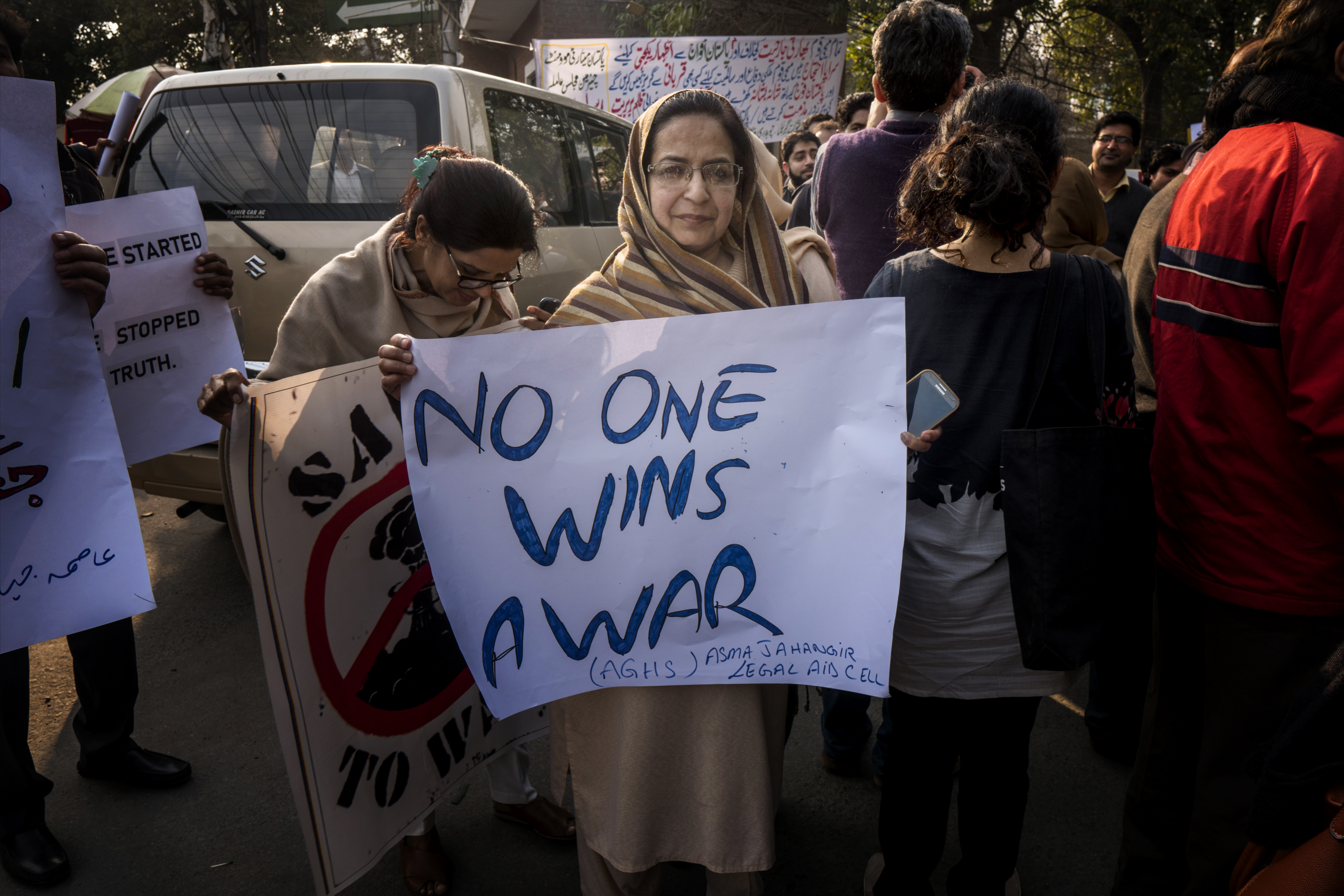
“The #AntiHateChallenge campaign was solely led by women from Pakistan to express solidarity with Indian friends. We were the first ones to break the silence and talk about peace,” says Mirza. “We mostly get to see such campaigns initiated and led by men.”
This year, women are taking a central stand against the region’s long history of conflict, militarism, and war, with both the Aurat March and Aurat Azadi March explicitly denouncing the creep towards war, and exhorting the nuclear-armed neighbours to issue a ceasefire in Kashmir. “We push for peace and against the war, the militarisation of our everyday lives, and a rhetoric of jingoism,” read a statement from Aurat March on Wednesday.
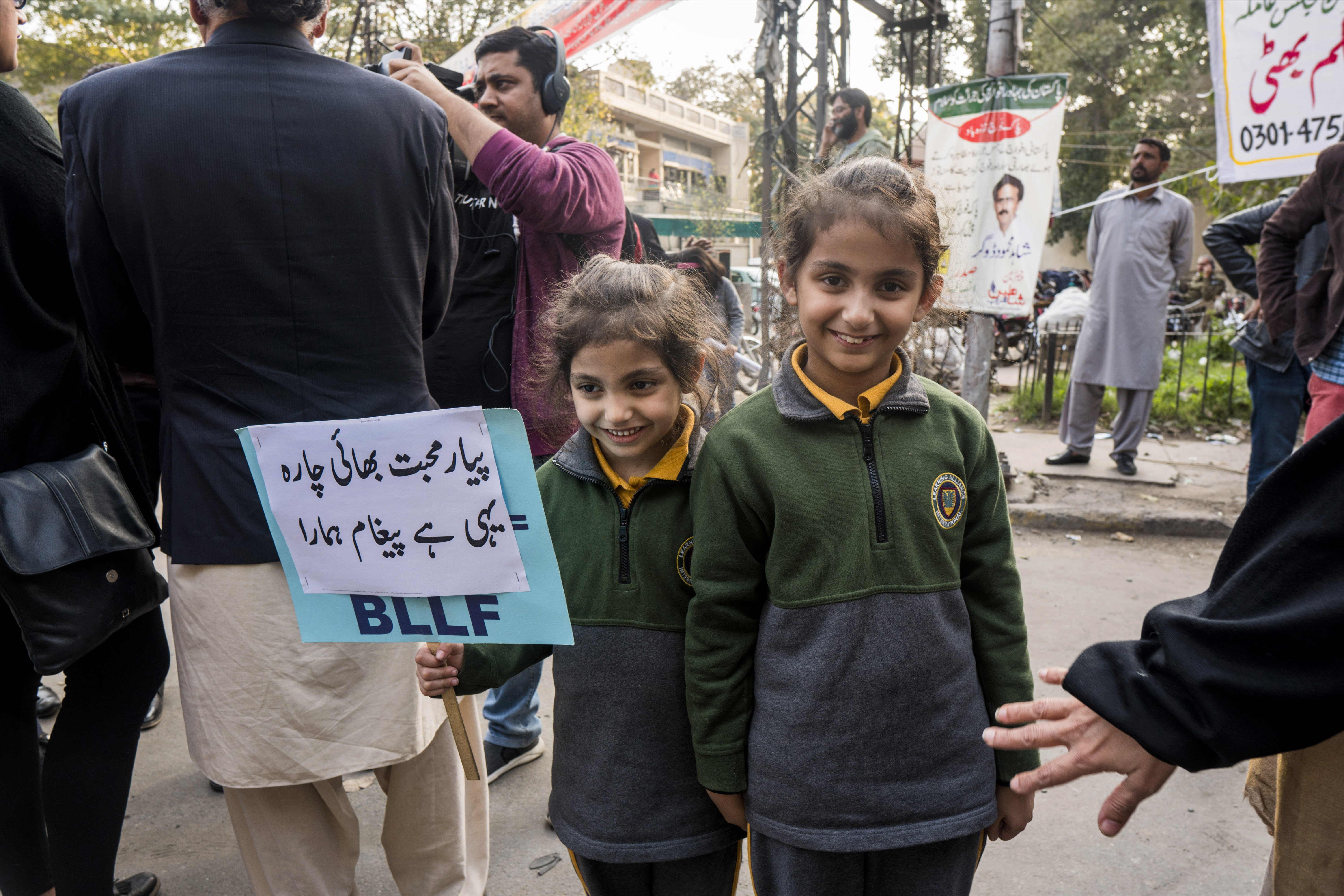
“Women would be the worst-off if a war starts between two nuclear-armed nations,” says Farooq Tariq, a Lahore-based political activist who helped organise the Global Standout for Peace in South Asia last week. “The financial crises during war means women would face tougher lives and have to compromise on food, health and education of the entire family,” he adds.
While social media has spread nationalistic displays of patriotism, it’s also allowed feminists to connect over their shared goal for peace. “We need to foster more spaces for dialogue between the people of the two countries,” says Syed. “I think Twitter has become the primary digital space where dialogue has taken place.” By using the hashtag #SayNoToWar, Syed has been able to meet like-minded Indians, and also askedher own government to release the Indian pilot who was captured by Pakistanis and subsequently let go last week.
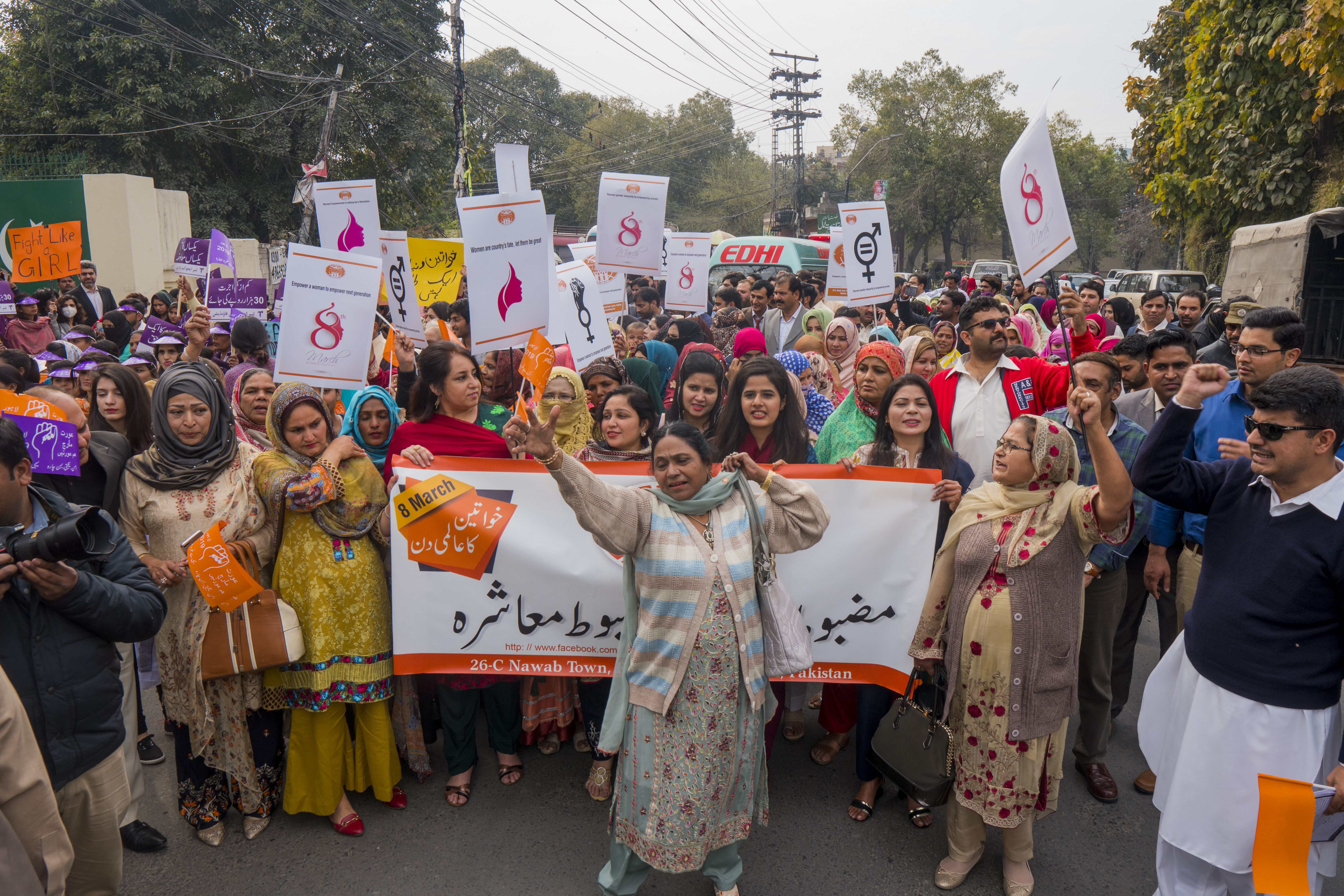
Currently, public opinion in Pakistan and India remains highly divided regarding the recent military actions in Kashmir. “We are sadly used to these periodic tensions,” Kirmani says. “They are part and parcel of the way nationalism has been conceived in both countries.”
Nevertheless, many Indians and Pakistanis continue to work towards building ties with one another and maintaining the relationships that already exist between the two countries. “I do have family and friends in India. Of course that makes it harder to dehumanise the ‘other’,” says Kirmani. “But I know we are also the ‘other’.”
Scroll down to see more photos from the 2019 Aurat March.
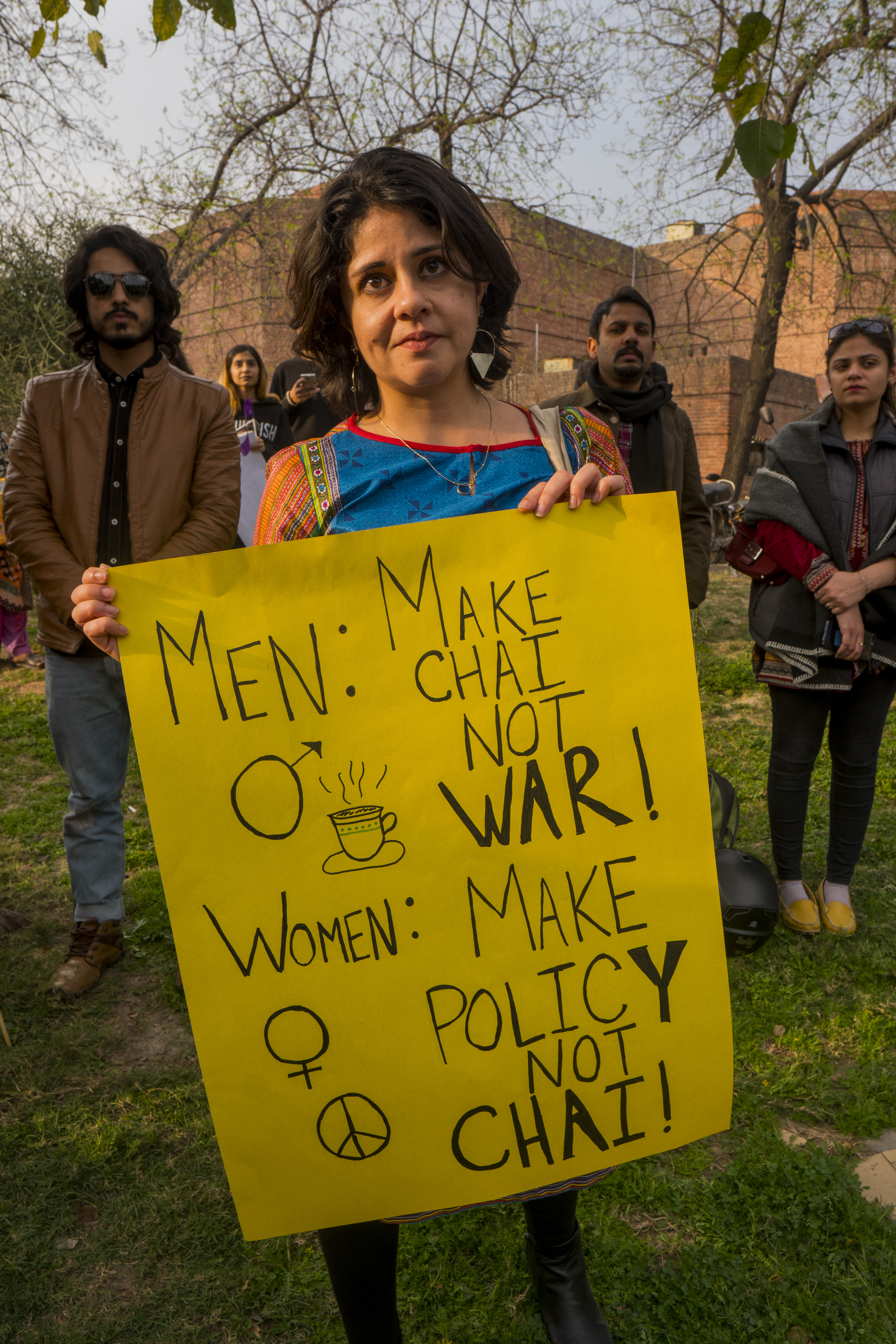
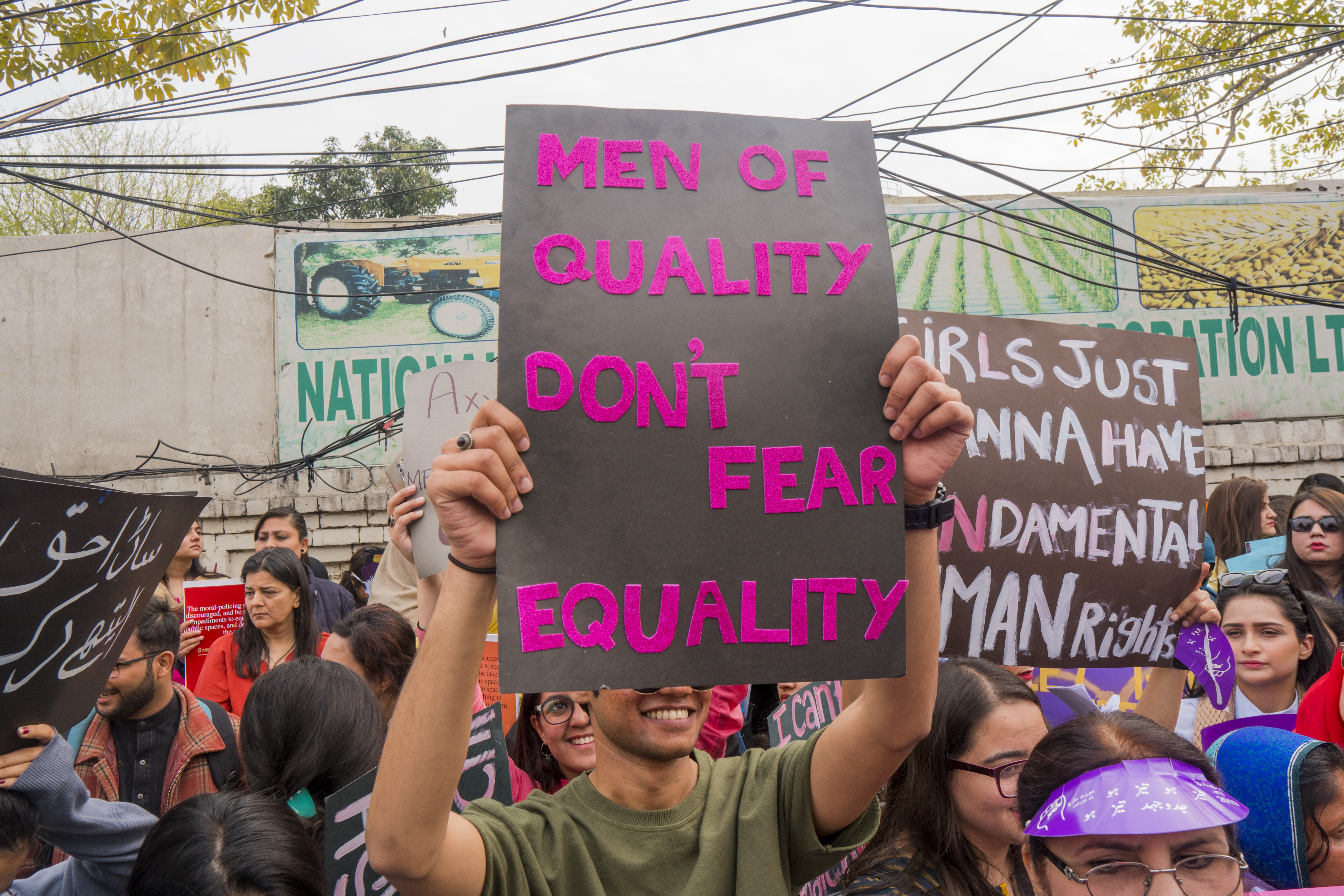
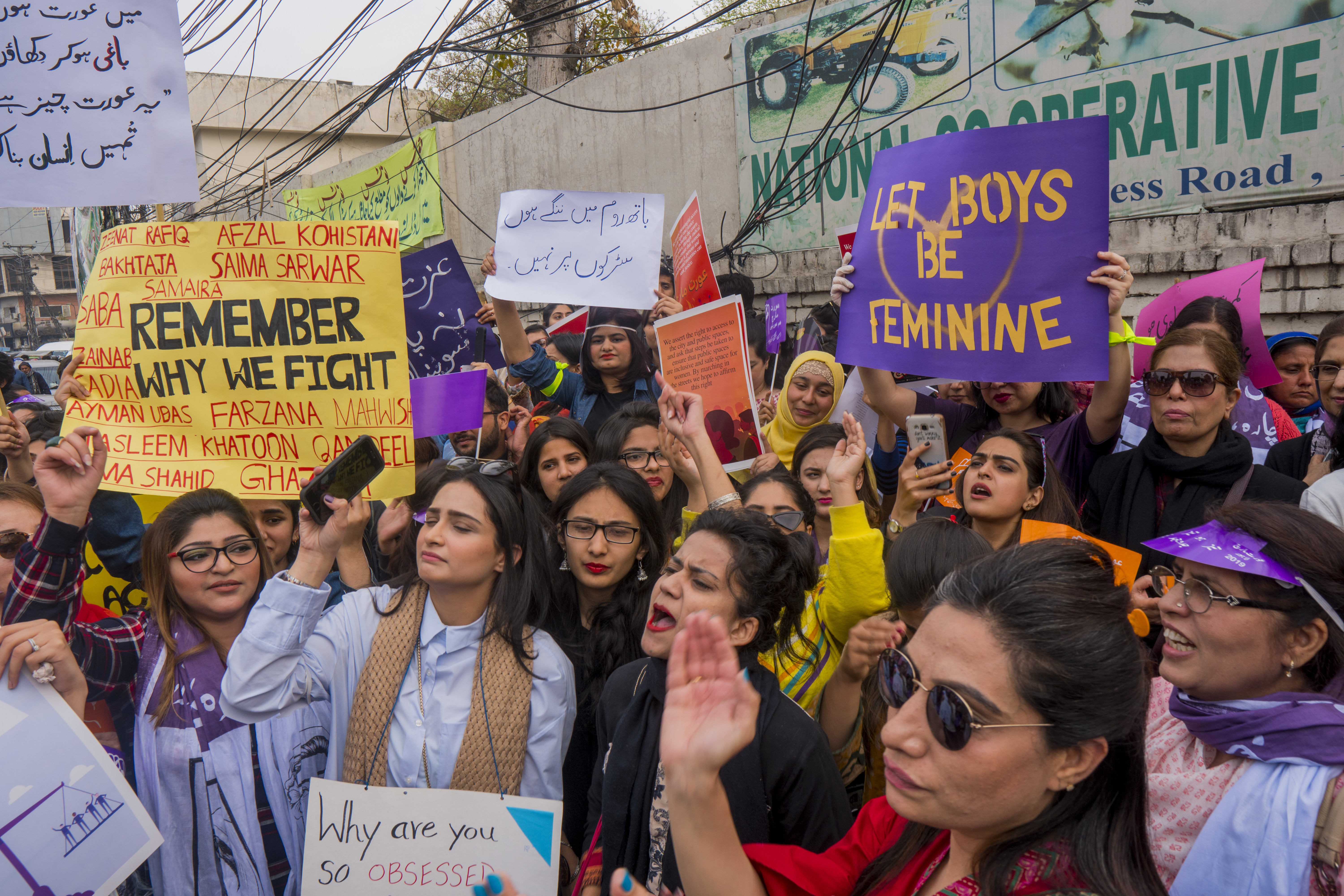
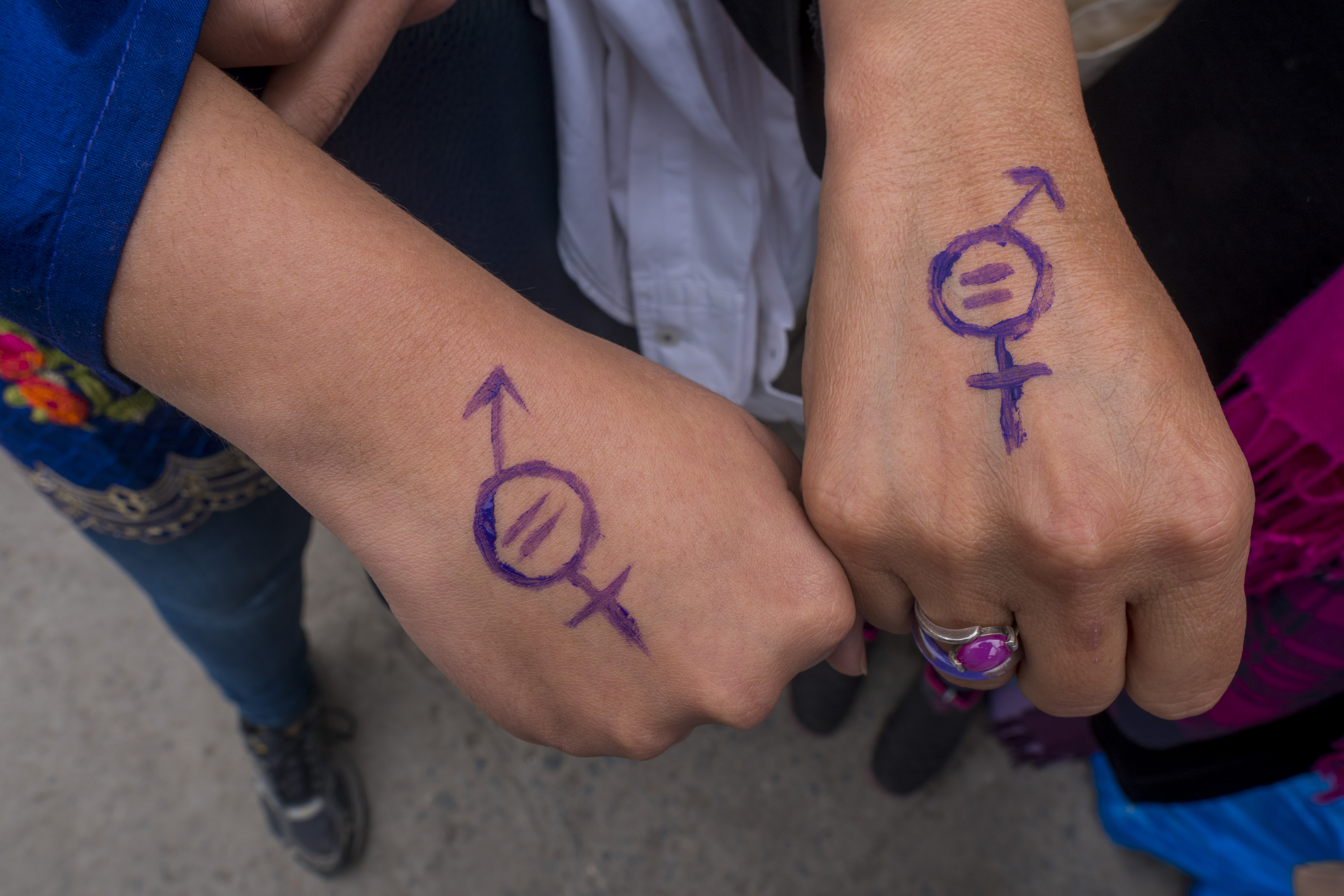
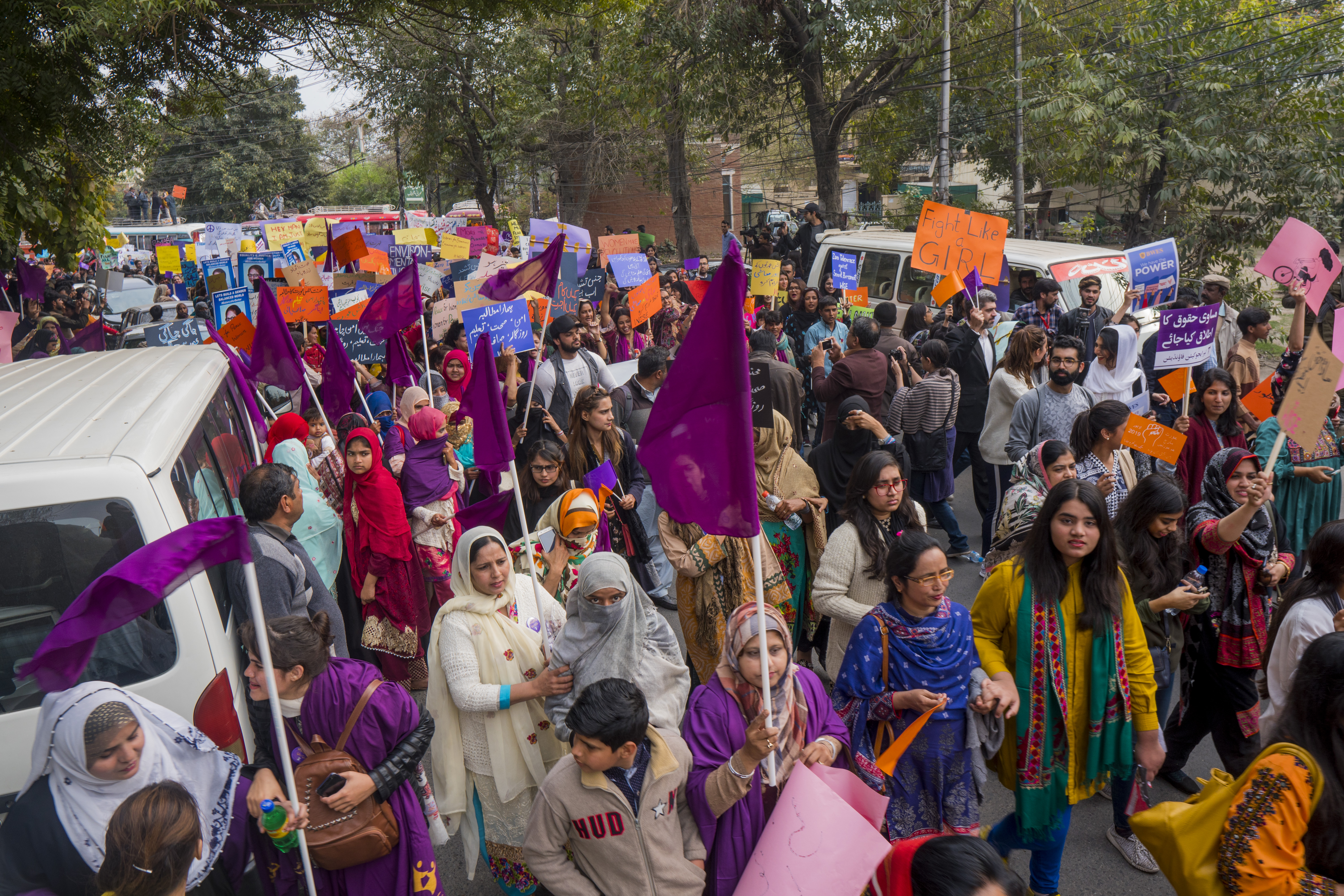
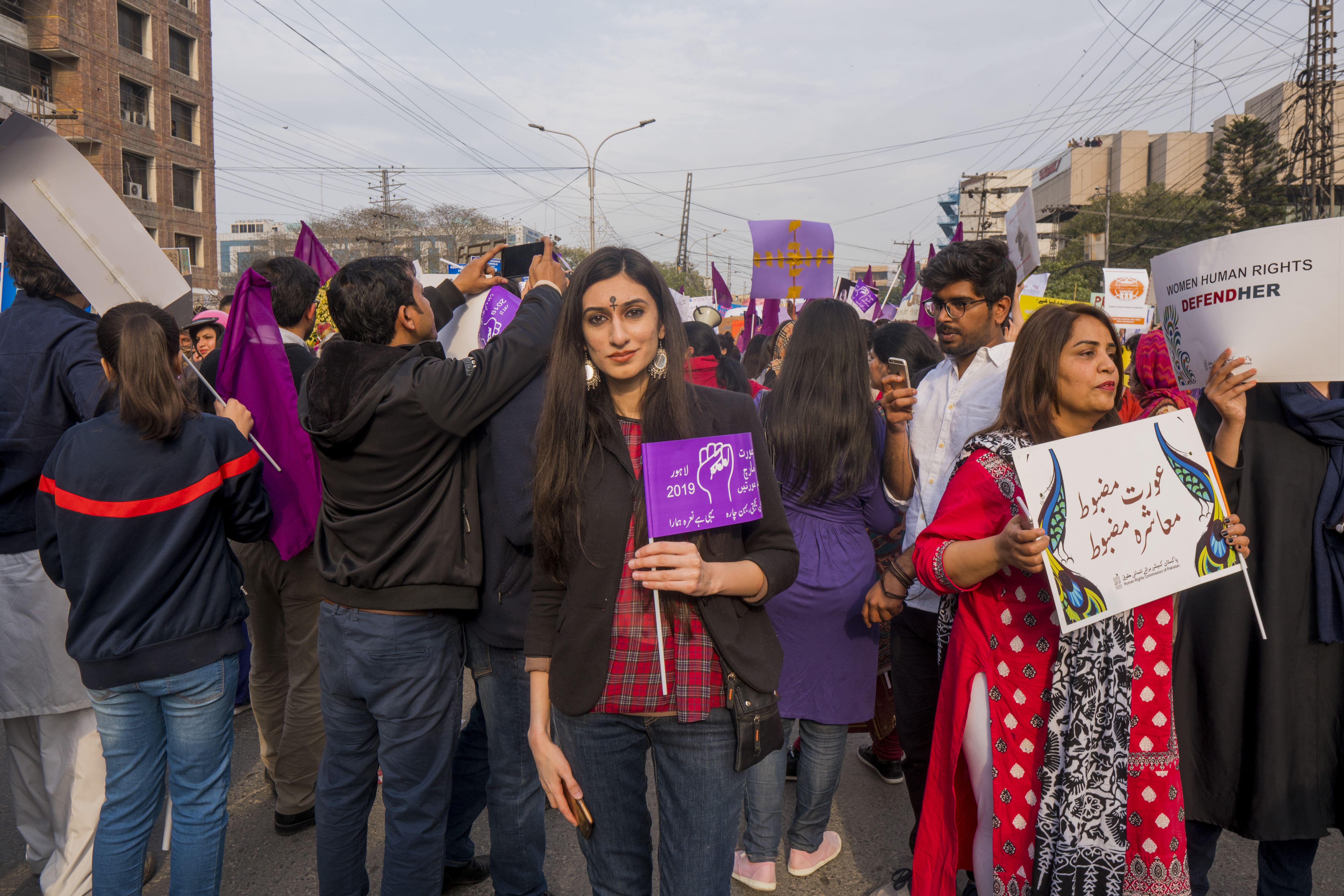
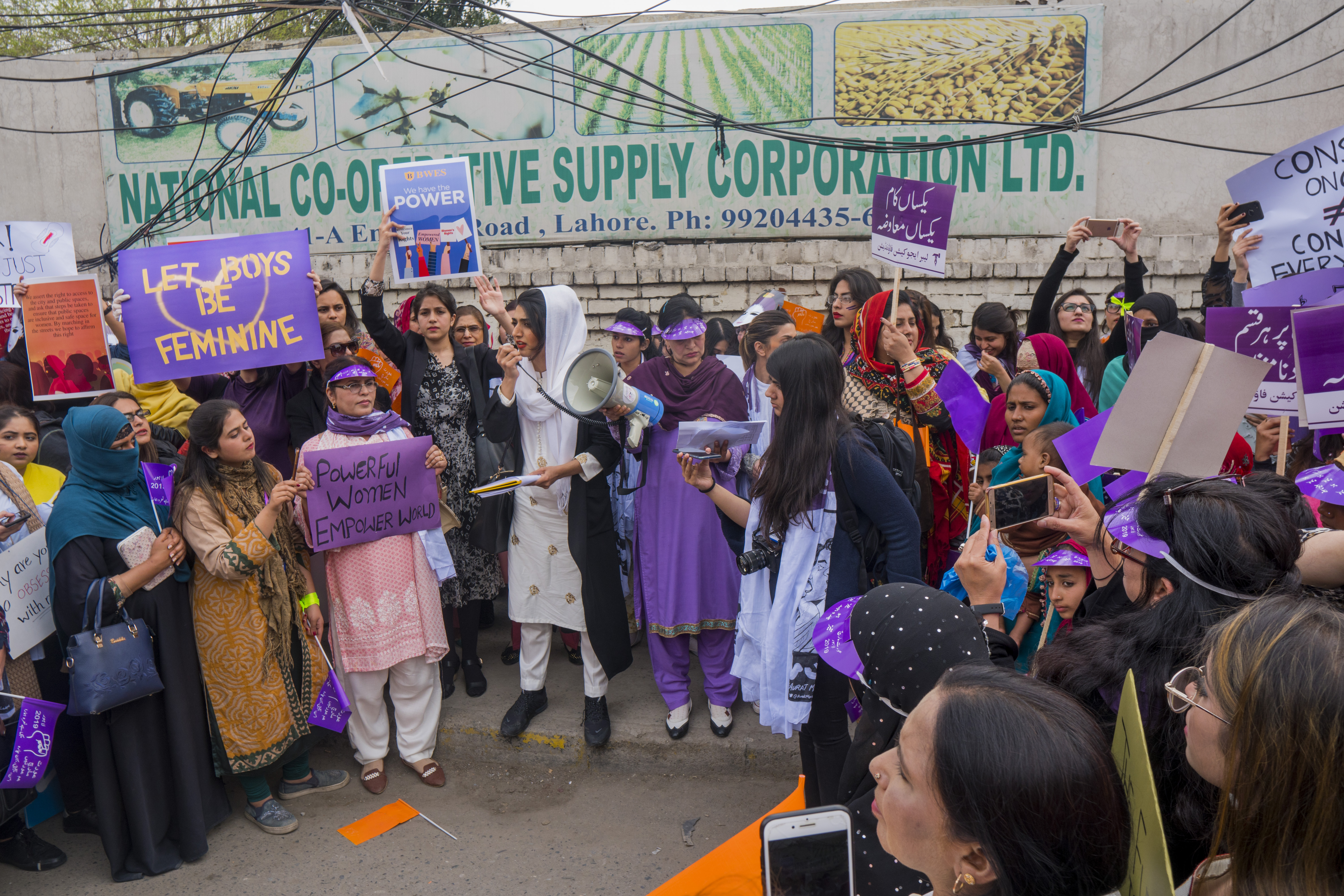
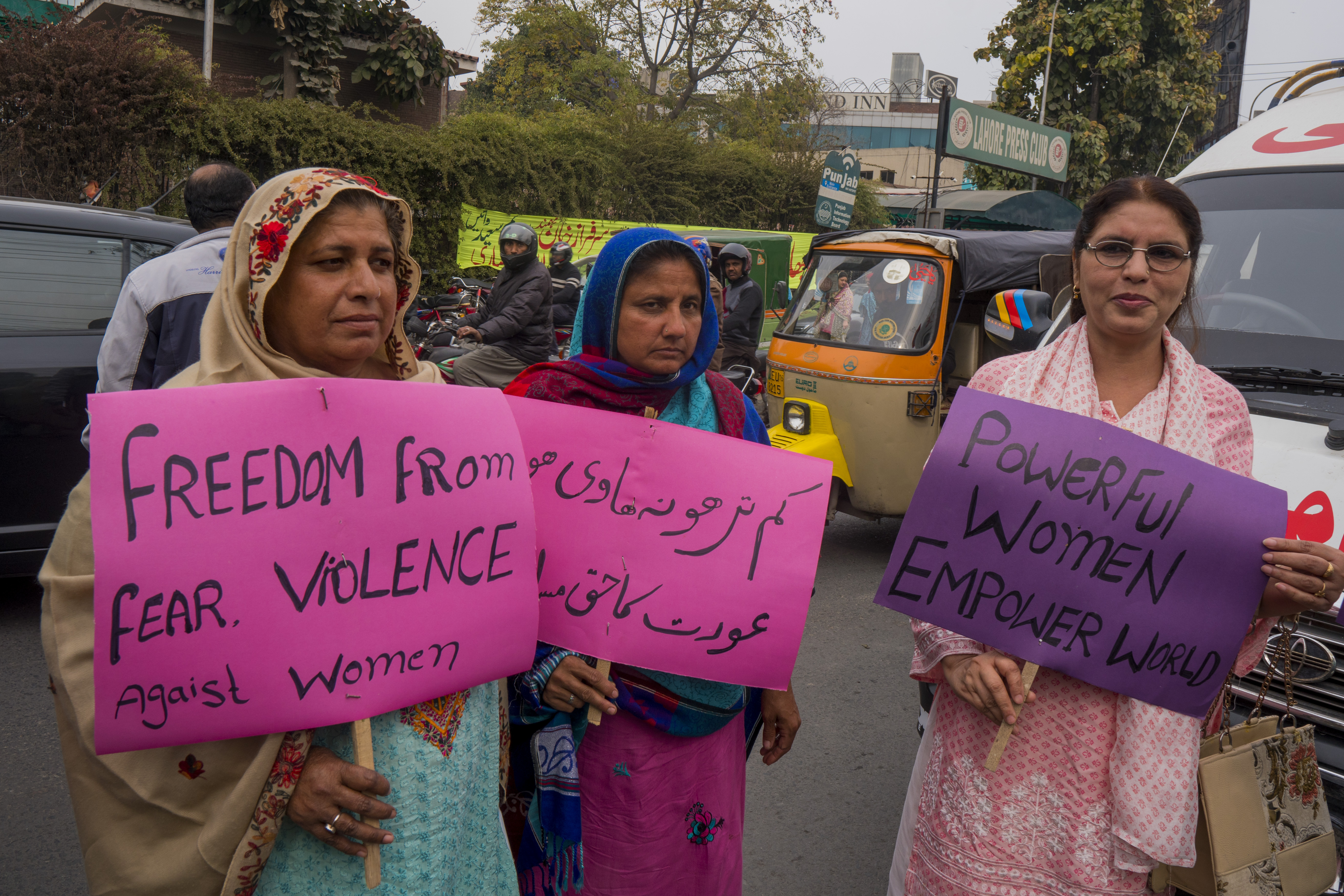
By Saad Sarfraz Sheikh for Herald, DAWN.
Updated Nov 24, 2018 01:53pm

Up, up and above they carried Daulat to her father’s home. Daulat’s soul is just 18, on the cusp of adulthood, the best years of her life. But her lifeless body has to be carried on foot from Pallas to Jijal village, in Kohistan – land of the mountains.
Daulat’s brother, with four other men, carry Daulat on their shoulders. They traverse across the mighty Indus on swinging wooden bridges and over large rocky terraces of ruthless mountains. The men take small breaks and change positions when rain showers them with stones. At night they stop and guard Daulat’s eternal bed. Moonlight peeks through the tips of three mighty mountain ranges – Karakoram, Hindu kush and Himalayas – teasing the peaks to try and hide its luminescence.

When the sun comes up, the men resume walking. There is very little conversation. A traditional fable is on everyone’s mind.
Daulat’s brother and a couple of others are sick. But stopping means inviting death. Daulat and her father would never forgive them. Around them, trees dance in an ancient trance, urging them to go on.
In the distance they can see Jijal, and in Jijal, they can Daulat’s father, beckoning her to rest beside him forever. The crack of shovel hitting the gravel fills the air. The shovel digs in and emerges with a mound of dirt of Daulat’s childhood home.
Daulat’s brother and his co-travellers lower Daulat into the earth. Daulat is finally home.

Such are the ways of the mountains of Kohistan. From the dead to those who inhibit the hauntingly beautiful valley of Kohistan – transportation is always a rite of passage.
You can’t see any women in Kohistan. They stay hidden. Inside the walls of their homes. But only until they die.
Under Kohistani tradition, when a married woman passes away, she has to be buried in her parent’s home. Relatives carry the body for days, crossing mountains and rivers to reach the woman’s paternal home for burial.
The landscape in Kohistan is hauntingly beautiful but basic facilities tragically horrible. Perhaps this is why, with the lowest literacy rate and human development index in Pakistan, Kohistan is described as one of the most backward regions of the country.

Except for a few, most villages in Kohistan require hours and hours of walking. Even those like Pattan and Dassu, that lie near the main Karakoram highway remain underdeveloped. There are no hospitals in the entire region, except for small rural healthcare centres. When not dysfunctional, these rural healthcare centres are only able to provide something akin to first aid.
For anything more serious than a fever, residents have to travel to larger cities like Mansehra and Abbottabad, hundreds of kilometres and at least half a day’s drive away.
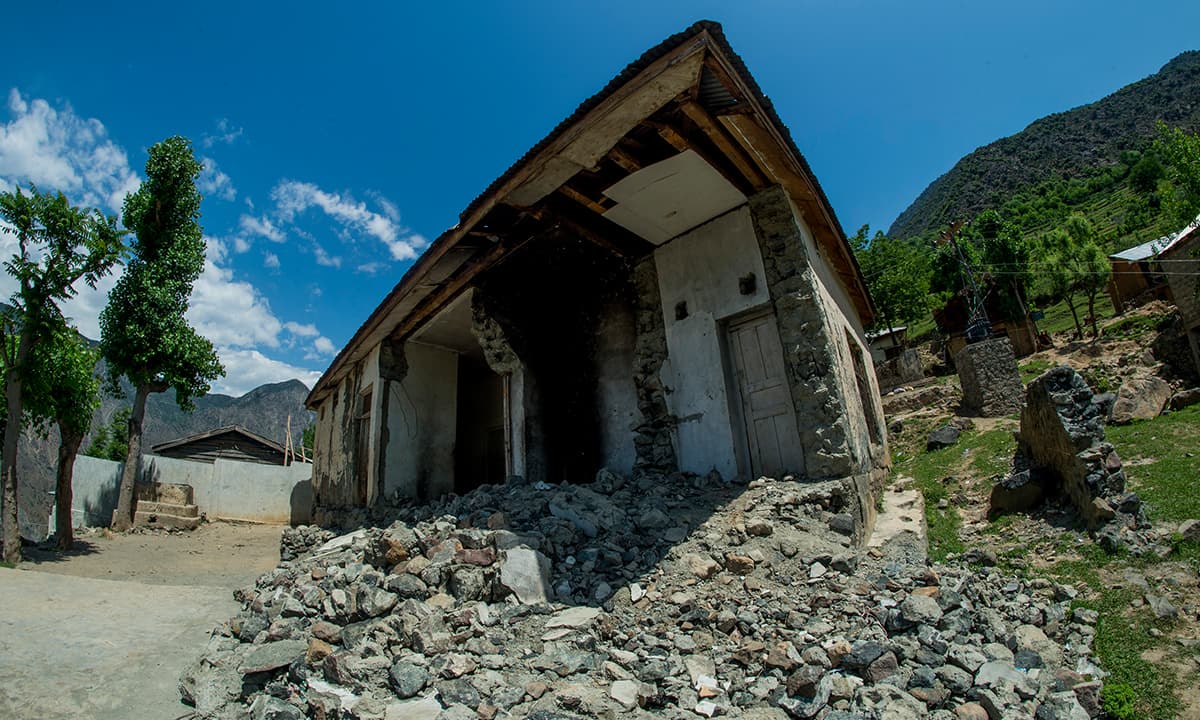
Kohistan’s inaccessibility – both physical and otherwise – remains one of the prime reasons (besides governments neglect) behind the region’s inability to develop. As one travels towards Kohistan from Besham – an important pit-stop on the Karakoram highway where national trade routes come to join – cellular service also disappears and unpleasantly large phones with antennas become a frequent sight.
Schools in Kohistan were built decades ago. Whatever was left of those buildings was badly damaged in the 2005 earthquake and has not been repaired since. It is common for children to walk for miles to get to school, only to collapse from dehydration while attending the morning assembly. Students walk to waterfalls located at some distance and bring back drinking water for schoolchildren to use throughout the day.

Unlike Pattan town that lies right on the Karakoram highway, Pallas is an hour’s drive away. It’s a treacherous drive, reachable only by jeep. In the evening light, the muddy floors of schools reminded me of abandoned caves.
Most of the local schools offer primary education. I met a father who had four daughters, and contrary to popular notions was worried about their education.
Government officials, on the other hand, conveniently cited fatwas by local clerics (against sending girls to schools) as an excuse for their ineptitude. Most of the fatwas were against co-education and their seriousness was exaggerated by government officers. They use clerics to keep complaining parents at bay.
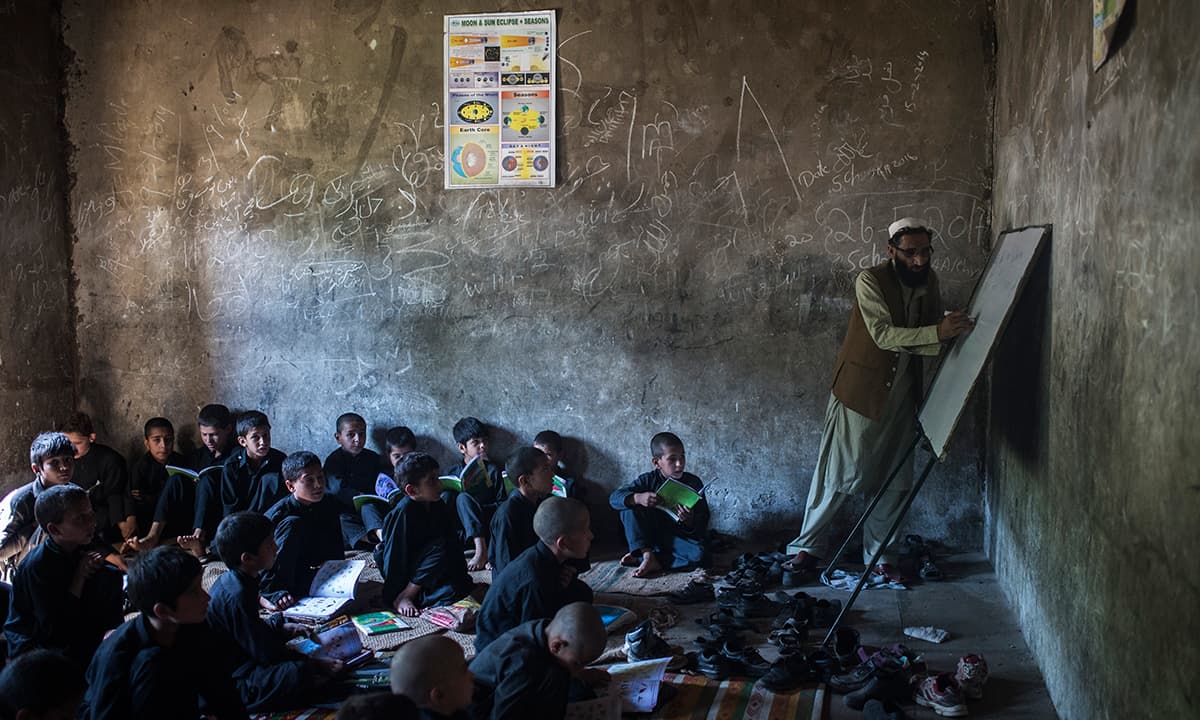
Just like the rest of the country, there are ghost schools in Kohistan as well. Teachers, appointed for petty political favours, receive salaries without having to do a single day’s work.
Perhaps it is Kohistan’s remoteness that has kept modernity away. On one hand, decisions made in Islamabad or even Peshawar don’t deem to have any impact here, on the other, it seems the region and its people are living in an era that has lived past its natural life. Despite our national depravities, modernity seems to have brought significant changes in our collective lifestyles but Kohistanis seem to be relatively untouched by it. Perhaps it is time for the Kohistanis to open up. Perhaps it is time for us to build better bridges.
The writer is a Lahore-based independent journalist and photographer.
This story was originally published in The Herald Magazine, Dawn. https://herald.dawn.com/news/1398727
Text and Photos by Saad Sarfraz for GEO.
The wide-spreading space, previously teeming with cranes and workers, is now dug up and abandoned. A half-constructed building, which was to be the Central Station, stands silent. Debris piled up around it. Here, in Lahore’s Harbanspura area is where the journey was to begin for Pakistan’s first metro train, the Orange Line. But work on the project came to a screeching halt, earlier this year.
Ignoring the on-ground reality, officials from the Lahore Development Authority (LDA), tasked to complete the project, insist that the Orange Line Metro Train (OLMT) is charging towards completion. Work is 90 per cent done and all 27 train sets had arrived from China in April, they add. But that was April. The Pakistan Muslim League-Nawaz (PML-N) was in power then. Its chief minister, Shehbaz Sharif, had launched the project in 2014 and was personally overlooking its construction. He had hoped to have the train up and running through Lahore, Pakistan’s second most populous city, before the July election. That didn’t happen. Now its rival, the Pakistan Tehreek-e-Insaaf (PTI), has formed government at the center and in the Punjab province.
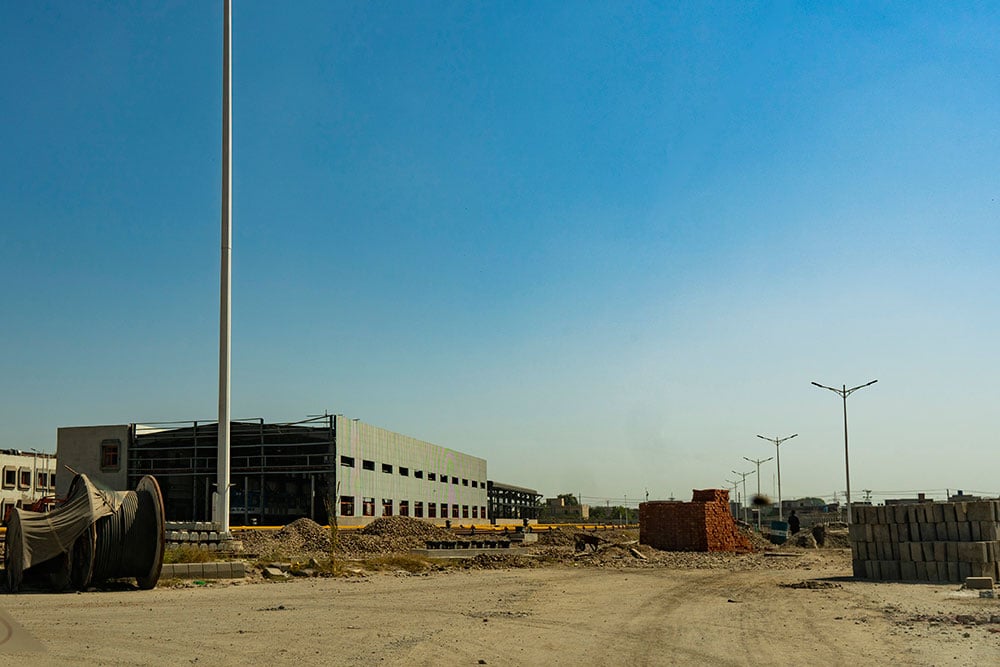
Once installed prime minister, Imran Khan, refuted any suggestions of a rollback on projects, such as the Orange Line, launched under the multi-billion-dollar China-Pakistan Economic Corridor (CPEC). But soon after, he promised to ensure more transparency going forward.
Last month, the prime minister’s commerce advisor was quoted by the Financial Times as saying that the CPEC “unfairly benefits Chinese companies” and suggested that such projects could be put on hold for a year to review the terms of agreement. However, the advisor later stated that his words were taken out of context.
Despite the assurances, work on the Orange Line has stalled. The remaining funds for the $1.6 billion project have yet to be released. The contractors haven’t restarted work due to non-payment since March, say officials, who spoke on the condition of anonymity.
Back at the Central Station there are few signs of activity. The Chinese workers, Geo.tv reached out to for comments, did not speak any English. No interpreter was present and their local counterparts avoided direct questions about the project. Till the sun set, the workers lay lazily around the site, against the backdrop of a blue locomotive gathering dust.
“The situation is quiet worrying,” said Khawaja Ahmad Hassan, the former chairman of a steering committee for the metro train. “There seems to be complete silence from the Chinese side. The new government has created an awkward situation.”
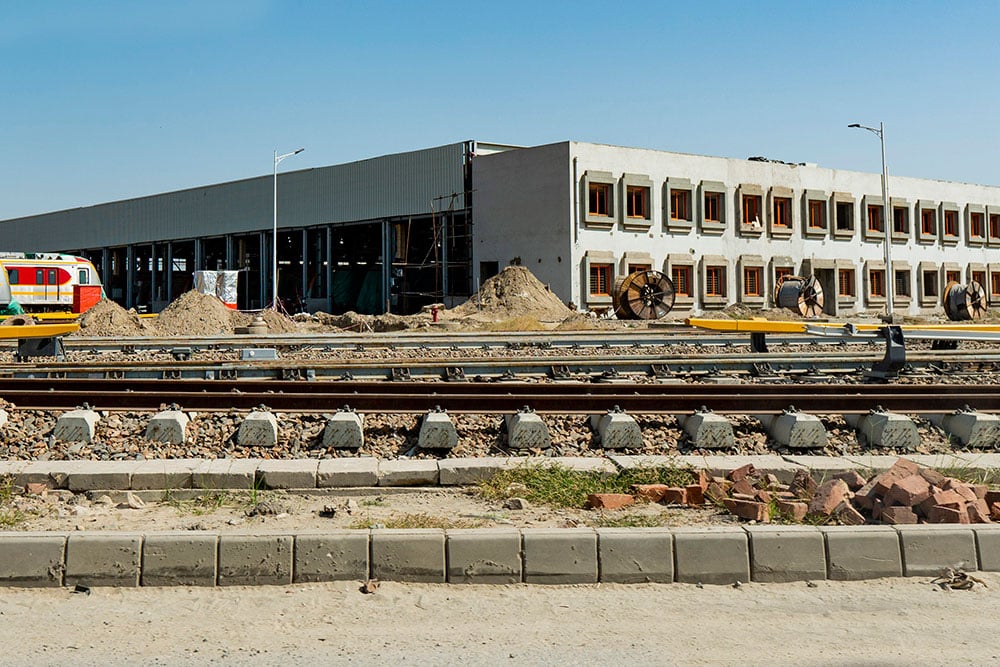
Launched in 2014, in collaboration with a Chinese company, the train is expected to run 27-kilometers through Lahore, and transport up to 250,000 passengers a day.
China’s Exim Bank provided Rs150 billion for the Orange Line, adds Hassan. While the China Railway Corporation and China North Industry Corporation (CR-NORINCO) sublet the construction to the LDA, which hired two contractors, the Habib Construction and Zahir Khan & Brothers.
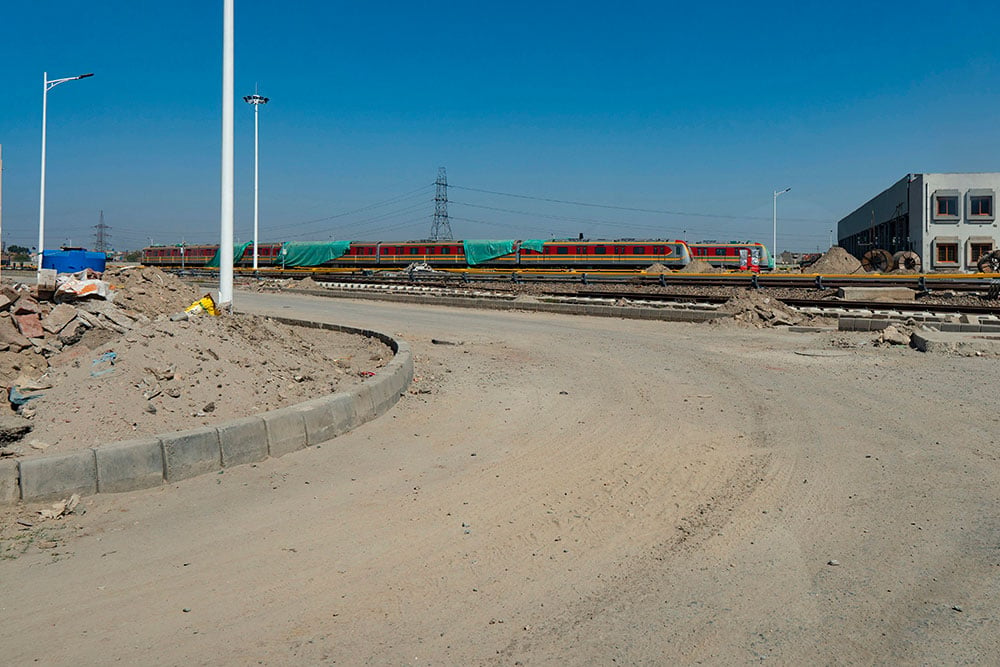
Even before the PTI came to power, the high-speed rail encountered many speed bumps. The OLMT was expected to run by October 2017. That deadline was missed, as it ran into legal troubles. Later, the Supreme Court gave it a go-ahead. A new deadline was set: March 2018. But that too came and went.
“The previous government gave us an unrealistic timeline,” an employee of the Habib Construction Services (HCS), who asked not to be named, told Geo.tv. The HCS and ZK&B were responsible for the civil works, including laying the train tracks, and setting up the stations, which they have completed. “The project has now been handed over to the Chinese firm, CR-NORINCO, which will work on the mechanical and electrical aspects. Some minor construction from our side is left, but our bills have not been paid,” the employee added.
Defending the PML-N government, Hassan said that the delay in payments was due to the court hold-ups which led to a hike in the cost. “We needed an additional Rs 15 billion, which the then-chief minister said would be raised locally.”
Now the PTI government has “inherited the costly project.” In a speech to the Punjab assembly, Makhdoom Hashim Jawan, the provincial finance minister, estimated that the previous government owed the contractors Rs 60 billion. He further called the OLMT an expensive publicity project launched in the name of development. “The former government declared that it would cost Rs 165 billion, but Rs 250 billion were spent and the project is still incomplete,” said the minister.
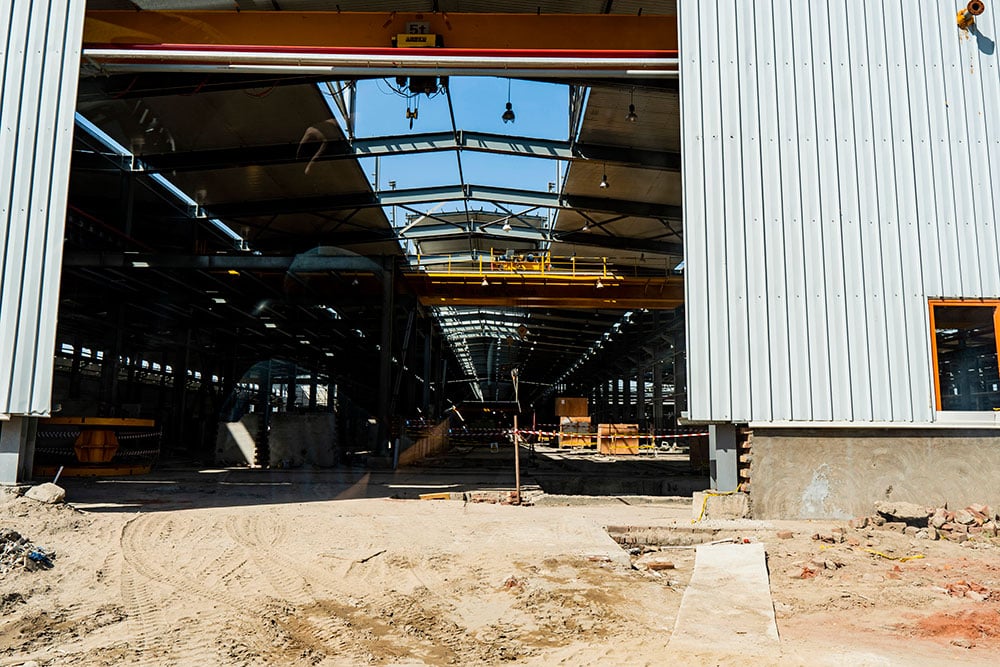
Unworkable targets aside, the cost was also driven up by lack of planning by the outgoing PML-N government. The feasibility reports were hastily prepared and the construction started prematurely, explained a HCS employee. “A project like this had never been attempted in Pakistan, hence there were many hidden costs. The prices of which were underestimated.” Another senior representative of the company says, “The 22-month-long court stay and the rising cost of steel and concrete increased the overall overheads.” Their deficit, he claims, runs up to Rs 3 billion.
The issue of non-payment was also raised in the Supreme Court while it was hearing the OLMT case last year. The construction firms informed the Court that two cheques issued to the company by the PML-N government had bounced.

Meanwhile, a report in a local daily called the OLMT the most cost-intensive project in world, led to the CR-NORINCO releasing a statement on September 1 to put to rest any speculation: “It was mentioned in the [news] report that the government has procured 27 five-car trains (total 135 coaches), besides track laying and electrical and mechanical works by Chinese engineers, for whopping a $1,000 million, which is over 60 per cent of total project cost. However, the above-mentioned report disaccords with the facts after verification. As a matter of fact, the total contract value undertaken by the joint venture of China Railway Corporation and China North Industry Corporation (hereinafter referred to as “CR-NORINCO”) is $920 million.”
But the confusion persists, at all levels of the project.
No one even at the Lahore Development Authority wants to take responsibility. When asked to comment, assistant directors at the LDA would say, “We have nothing to do with the project,” before redirecting it to someone else.
But someone will need to step up. Someone will need to roar up the engine and personally helm the project towards completion, if Pakistan is to get its first metro train.
Originally published here: https://www.geo.tv/latest/215802-the-orange-line-metro-train-which-way-forward
Sheikh is a freelance writer based in Lahore
It’s August 20. Inside the civil secretariat building in Lahore, the staff is moving at a rapid pace, removing and replacing official photographs mounted on the walls. Below Quaid-e-Azam’s irreplaceable, all-seeing portrait is that of a man who has ruled Pakistan’s most populous province for a continuous decade. Shehbaz Sharif, Khadim-e-Aala, is Punjab’s longest-serving chief minister. Even when the central government changed hands, the 110 million-strong province remained the Pakistan Muslim League-N’s throne.
But 2018 had not been all that kind to the former prime minister’s younger brother. There is a new Pakistan on the horizon. Things are a tad bit different here. In the new order, the 66-year-old’s portraits must go; a new sheriff is in town.
Enter Usman Ahmad Khan Buzdar, an unknown. At first blush, he seemed withdrawn and low profile. He didn’t have Sharif’s demeanour or confidence or an assertive last name.
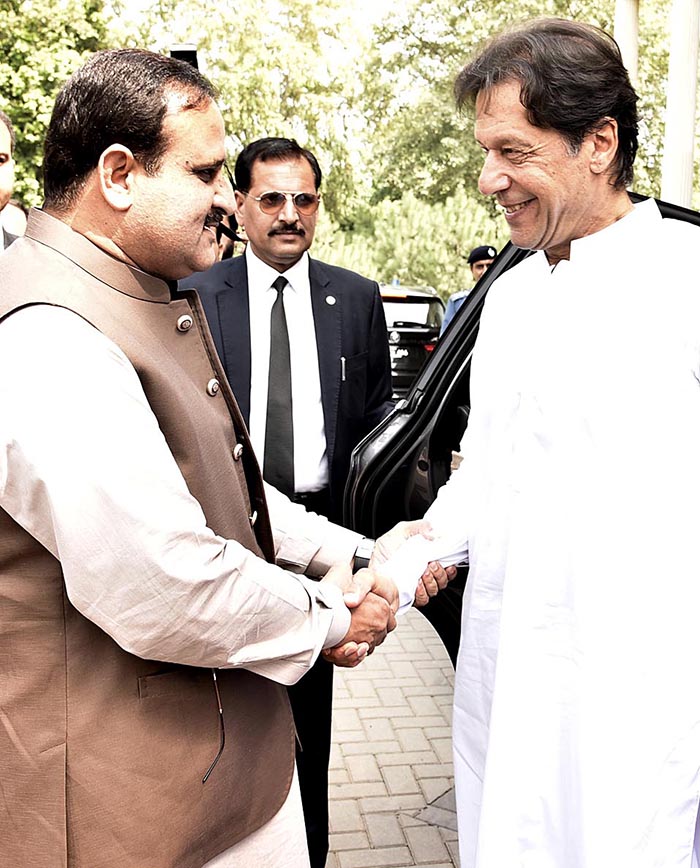
Buzdar is from the underdeveloped southern stretches of Punjab, nominated by incoming Prime Minister Imran Khan on August 17. When his name came up, there was much shock and confusion. No one had a ready profile of the new man in office. Then, some controversy arose and the media licked its lips. A case registered in 1998 accused the chief minister of involvement in the murder of six people. But the allegations were quickly cleared. The accused was a mere namesake, with no connection to Buzdar.
On August 20, the 49-year-old was sworn in. Since then, his first month in public office has been quite interesting.
According to government officials, he is a mystery. At the end of a long introductory session with the Planning and Development Department (P&D) of Punjab, tasked with ensuring economic planning and development, Buzdar only asked one question, revealed an official in attendance who asked not to be named. The chairman of the department provided a detailed briefing of the P&D’s budget and objectives. Upon conclusion, “the chief minister gave a short, prepared speech, with no connection to the presentation,” added the official, “in which he also mentioned how he himself was surprised at his selection for the slot of the chief minister.” However, he did promise to support the bureaucracy and asked for their guidance.
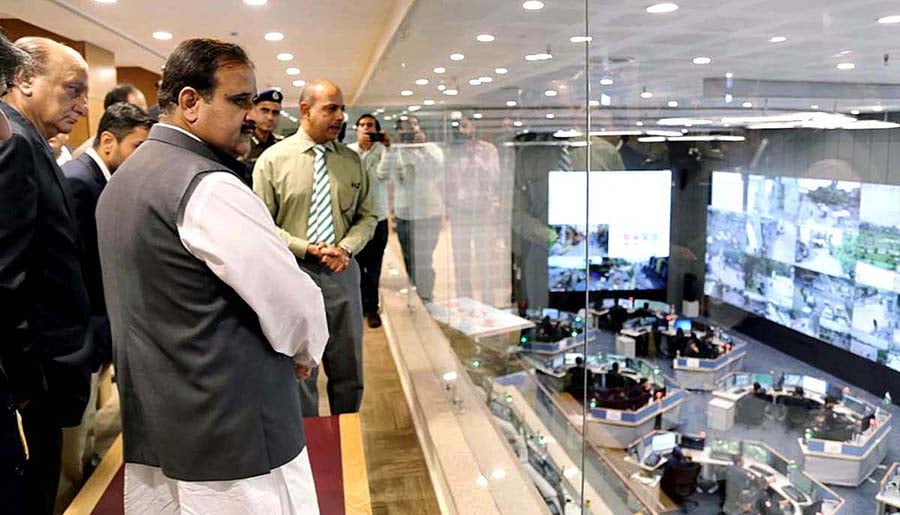
Sharif was a one-man show. His style of doing business was often excoriated for being authoritative. Buzdar, ostensibly, will be relying on his provincial cabinet, populated with strongmen, and the federal government for direction – at least that is how certain bureaucrats Geo.tv spoke to view it.
“Buzdar’s ministers have been given ample free reign,” said another official, on condition of anonymity. “They are in the process of formulating policies.” The CM is expected to look into administrative tasks, like removing land encroachments, while his senior minister Abdul Aleem Khan is likely to head the new provincial government’s 100-day agenda around education, energy, and health.
Murmurs like these create confusion about the chief minister’s own vision. At the same P&D meeting, Buzdar promised no shuffling of the bureaucracy, but then soon after men were moved to Sindh and the Khyber Pakhtunkhwa province. By one account, there are two to three transfers every day. But despite complaints by civil servants, an official admits that many of those relocated had been in office unfairly and for far too long due to their loyalty to the previous ruling party.
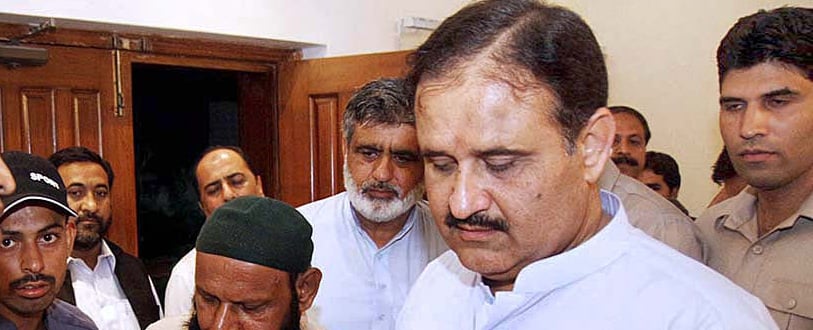
One transfer that generated the worst press was that of Pakpattan’s District Police Officer, Rizwan Gondal. He is said to have had an altercation with the first lady’s ex-husband, after which Buzdar, reportedly, intervened to have Gondal sent to another city. The case is now being examined by the Supreme Court.
But even if the chief minister started off on the back foot, come September he has revved up his administration style, which is now more reflective of the man before him. Civil servants say he has sent a warning to absent officials, and conducted surprise visits to police departments and district courts in Rawalpindi. During one such ‘raid’, the Deputy Commissioner Rawalpindi, Dr Umer Jehangir, and the Central Police Officer were missing from their offices. The chief minister was irked and only left when he was assured that the men were on an anti-dengue monitoring campaign.
But at the end of the day, despite the efforts, Buzdar is still viewed as a filler, a temporary chief minister, likely to be replaced in a few months. Punjab, the thinking goes, is too important a province politically to be handed over to an unknown and inexperienced man. Perhaps the new government is looking for someone who can outpace Shehbaz Sharif’s legacy a lot quicker.
Sheikh is a freelance reporter based in Lahore.
Originally published by GEO: https://www.geo.tv/latest/211483-usman-buzdars-first-month-in-office-four-weeks-of-uncertainty
Note: The views expressed are those of the author, and do not necessarily reflect the official policy or position of Geo News or the Jang Group.

“Till you don’t fight for your rights and your truth, you can’t expect a positive change,” Ali said, and the battle has been long. In the 19th century, the region’s British rulers had labeled the Indian subcontinent’s transgender community a “criminal tribe.” And unlike many other social groups that were criminalized for challenging the British, the transgender communities on both sides of the blood-soaked India-Pakistan border have largely remained mocked, loathed and marginalized in the decades since independence in 1947.
YOU CAN NOW SEE HOW THE STEREOTYPES ARE SLOWLY BEING BROKEN.
JANNAT ALI, TRANSGENDER ACTIVIST
But the reception Ali received at the Lahore event is indicative of slowly shifting attitudes toward the transgender community in otherwise conservative Pakistan, marked by growing acceptance of their gender by the government, sections of society and even religious scholars. They are still victims of stereotypes and violence, and the road to parity with the rest of society remains long and hard. Still, the momentum toward change is building like never before. Islamabad’s Allama Iqbal Open University announced free classes — from junior high to college — for the transgender community in October. This past summer, Pakistan’s government issued its first third-gender passport to a transgender activist, Farzana Jan. In 2009, the country’s Supreme Court urged provincial governments to facilitate rights of their transgender communities; in 2012, the country’s National Database and Registration Authority provided an option for the third gender on its ID cards. In 2017, the national census recognized the transgender community for the first time. And a bill to protect the community’s rights is currently before Parliament.
In 2016, activist Kami Sid became the first Pakistani transgender model to be featured in a fashion photo shoot. Transgender activists and performers participate in popular television shows and on national radio, and as panelists and guests at events and festivals. Ali, valedictorian in her MBA program and a trained kathak performer, was invited last year to speak at a prominent college and a private school. And recently, Chairman of the Council of Islamic Ideology Qibla Ayaz labeled transgender discrimination unethical and un-Islamic.
“You can now see how the stereotypes are slowly being broken,” Ali tells me, when I visit the Khawaja Sira Society in Lahore, a community-building organization where she works as a coordinator.
Founded in 2012, the KSS and its work represent a microcosm of both the attitudinal changes in Pakistani society toward the transgender community and the challenges that continue to pothole the path ahead.

Some, like the aptly named Lucky, may appear more fortunate than others — but theirs too is a story of struggle. Slim and petite, with her hair pulled back in a short ponytail, Lucky, a KSS outreach worker, knew she was different by the time she was 5. Her parents, who worked at a Lahore college, knew soon enough too, but ignored the subject. When she turned 13, Lucky left home after a fight with her family. She lived on the streets, barely surviving off money earned from sex work and alms. But a few years later, after her mother took ill, her parents asked her to move in with them again. A passionate singer and occasional actress, Lucky acted in Teesri Dhun: The Third Tune, a 2016 theater production on the lives of Pakistan’s transgender community that was also performed at American graduate schools, including Yale and the University of Texas at Austin. “My mother and my father came to watch my performance along with my boyfriend,” Lucky says. “It was such a perfect moment for me.”
Others struggle to get their loved ones to acknowledge them in public. Nirmal, another outreach worker, says her boyfriendof six years refuses to be seen with her in public. “He says, ‘What if my friends make fun of me?’”
Transgender activists continue to face taunts from the police — and ordinary people, at times — while on outreach programs, accused of promoting sex when they hand out condoms. And the recent policy changes introduced to help the community represent “only a drop in the ocean,” says Neeli Rana, a veteran transgender activist. Although embittered by years of promises to the community that she says have mostly proved hollow, Rana continues to fight “for our next generations” and their right to work wherever they wish to, without any backlash.
Others are seeing signs of compassion, starting with their families. Ashi, another prominent transgender activist, fled her home at the age of 13 to escape a physically abusive father who wouldn’t accept her. Years later, when her father had been bedridden for two years, Ashi returned home — the only one of her siblings to do so — and she now looks after her 86-year-old mother.
On his deathbed, Ashi’s father wept and begged for her forgiveness. “I cried and told him I’d forgiven him a long time ago, and that he was my parent and that it was my duty to care for him,” she recalls. That sense of duty, felt for its transgender community, is something Pakistan may be waking up to.

Javed Iqbal travelled to Faisalabad International Airport 15 years ago to catch a one-way flight to Dubai. Two years later, in 2004, he was sent back to Pakistan after medical tests revealed that he was infected with the human immunodeficiency virus (HIV), a precursor to acquired immunodeficiency syndrome (AIDS). Then 27, he had no idea how and where he had contracted the disease.
Iqbal then attempted to move to Saudi Arabia for work, but his job application was rejected after he underwent a medical test. Embarrassed and dejected, he resumed his life in his native village, Chak No 127, Bhattiwala in central Punjab’s Chiniot district, without telling anyone about his illness. He also did not seek any treatment. He was scared of being named – and shamed – for suffering from a disease generally perceived to be the result of indulging in sex practices that religion and society abhor and prohibit.
Some time later, Iqbal married a local girl despite his deteriorating condition. He died in February this year, leaving behind his widow who, according to a local health worker, is also infected with HIV.
Bhattiwala lies midway along a 37-kilometre road that connects Chiniot with Faisalabad. Like any other village in this part of the country, it has mud-plastered houses and herds of buffaloes meandering lazily amid its green fields. Most of its inhabitants are small farmers who, like Iqbal, require supplementing their meagre farm income with additional work. The village is a picture of official neglect. It has only one government primary school (set up in 1956-57), its drainage and sewerage systems are primitive and it does not have a single government-run healthcare facility.
It is by no means equipped to tackle the HIV/AIDS scare that, in recent years, seems to have hit a large number of people living in the village, including men, women and children as young as five years of age, says Mazhar Qayyum, who runs a private school near Bhattiwala. He switches between English and Urdu as he explains how the entire village blames Iqbal for the spread of the disease. Whether that blame is entirely justified or not is of no consequence to villagers like Ahmed Yar who have lost almost their entire families reportedly to HIV/AIDS.
Wearing a worn-out shirt and a piece of unstitched cloth wrapped around his legs, Yar is the personification of poverty and resignation. A farmer in his 30s, he has lost nine members of his family (his father, mother, six siblings and his sister-in-law – all in the previous 12 months). They were being treated by a local quack doctor before their condition deteriorated and they were taken to Faisalabad’s Allied Hospital, the largest public sector medical institution in the area. The doctors there found that they were suffering from neurological complications. Other than that, Yar has no test reports or other documents to prove or disprove whether their deaths were linked to an HIV infection. “There is no point in finding out the reason for their deaths. It will not bring the dead back,” he says.
What he is more concerned about is the fact that his teenaged sister has a terrible cough that never seems to go away, and two of his paternal cousins have been found to be infected by HIV through tests recently conducted by the government.
Another local family has lost all its 12 members in the last two years reportedly to HIV/AIDS. Their house is empty and its boundary wall has all but collapsed.
In another part of the village lives Kaneez Bibi, a housewife in her 30s, who has three young HIV-infected patients in her home. Her four-year-old son and her two teenaged step-children – a 16-year-old boy and a 14-year-old girl – were found to be infected with HIV when a government team took their blood samples for testing a few months ago. None of the three children go to school. The eldest works in the fields despite his failing health.
On a recent October day, Kaneez Bibi’s very agitated little son is suffering from a bloated stomach. His hands are soiled and his skin is ruptured and blistered. His sister walks around the house chewing her red dupatta. She looks much younger than her age. Both the children appear bewildered and scared. The children receive free government-provided antiretroviral drugs that slow HIV/AIDS, but there has been little improvement in their condition. This could be because their parents are not observing the recommended precautions. The tablets they consume daily are kept in the open even when they are required to be stored away from sunlight at a temperature below 30 degrees Celsius. The patients also need to undergo weekly examinations by a doctor to monitor and address any side effects that the drugs may cause.
The medicine has supporting literature that states these recommendations very clearly but it is written in French and English — gibberish for the children’s illiterate parents. The doctors at the Services Hospital in Lahore who prescribed the medicine never said anything about any dangers or precautions, says Kaneez Bibi.

Jaffer Ali, an agriculturist in Bhattiwala who practices medicine in his spare time, has been the village’s main source of diagnosis and treatment of all major and minor ailments. An untrained and unregistered medical practitioner, he has only a smattering of information about medicine, but every household in the village deems him their saviour. He does not operate a clinic but visits his patients at their homes to administer some known painkillers, steroids and antibiotics for almost all problems or diseases. At least three other quacks similarly operate in the village, with as little expertise. Whether or not they know how HIV/AIDS is spread is subject to speculation, but they are certainly ill-trained to treat its sufferers.
The quack doctors’ favourite mode of treatment is administering injections — using one needle to give many injections and to many people. The villagers, too, believe injections work more quickly than tablets and syrups. Little do they know that each injection needs to be given with a new needle to avoid transferring one patient’s infections to another. And that could be a major reason why HIV/AIDS has spread so widely in Bhattiwala.
Zafar Sadhu, a local farmer, alleges that the quacks operating in the village have known the dangers of giving injections with used needles all along. But they would never admit that HIV/AIDS is transferred from infected people to uninfected ones through reused injection needles. “They would rather blame it on illicit sex than on their own wrong medical practices,” he says.
Such blame games became public early this year when stories of HIV/AIDS causing multiple deaths in Bhattiwala became too frequent for the local residents to ignore. Some of them wrote letters to Chiniot’s district administration, requesting the authorities to carry out an investigation. They also complained about the activities of illegal healthcare providers and sought the appointment of a qualified doctor for the village, says Sadhu.
A government medical team finally visited Bhattiwala in July this year. Headed by Dr Mushtaq Bashir Akif, then working as Chiniot’s district health officer, it took blood samples of 350 local residents randomly selected out of a total population of approximately 4,500 people, and tested them on the spot with portable kits. The tests found the hepatitis C virus in almost 250 of the samples. Even more worryingly, 45 samples were found to be HIV-infected.
The medical team took additional blood samples of those suspected to be infected with HIV and sent them to a government laboratory in Lahore for polymerase chain reaction (PCR) testing since on-the-spot tests are sometimes inaccurate, say health officials in Chiniot. PCR testing is deemed 100 per cent reliable because it is performed in a controlled laboratory environment with sophisticated equipment. The district administration claims it has not yet received the results of the tests from Lahore.
The electronic media soon got wind of these developments. Many television channels subsequently produced news pieces about those suffering from HIV/AIDS in the village. As news spread, Dr Adnan Zafar Khan, then the director of the Punjab AIDS Control Programme, travelled from his office in Lahore to Chiniot to find out more about the situation first-hand. In August, he appeared on News Wise, a news show on Dawn News TV and acknowledged that PCR results had verified the prevalence of HIV infection in Bhattiwala. However, he denied that there had been any deaths in the village due to the infection.
Soon afterwards, he was transferred out of his post as part of what the government called a routine bureaucratic reshuffle. Sources in the Punjab health department allege that he was punished for revealing the test results.
Dr Mushtaq Bashir Akif denies the prevalence of HIV/AIDS in Bhattiwala altogether. “Calling the sick people in the village as HIV positive is incorrect,” he says during an interview in his office at Chiniot’s District Headquarters Hospital (DHQ). Posted as medical superintendent of the hospital this October, and dressed cheerfully on a recent Saturday in a polo shirt with white and blue horizontal stripes, he suggests that the ailment afflicting the village could be something else. “Nine out of every 10 people living in Bhattiwala are suffering from hepatitis C, just like they are in almost every village in the area,” he says, almost chuckling.
His supervisor and chief executive officer of the district health department, Dr Akhtar Husain, rubbishes reports of large-scale deaths in Bhattiwala and claims to have taken multiple precautionary measures. He closed down many barber shops in the area since they could be a major distribution point for HIV/AIDS infection through blades reused for shaving multiple people. He also sealed clinics run by quack doctors in the village in order to save people from used injection needles.
District authorities have additionally registered a first information report (FIR) against three quack doctors for practising medicine illegally in Bhattiwala. Jaffer Ali’s name is not among them. He has been at large since the government crackdown against quacks.

Husain claims to have taken another important step as well: an AIDS centre has been set up at the DHQ hospitals where “a psychologist, a woman medical officer and a laboratory technician” are especially posted to take care of those suffering from HIV/AIDS. “[It] is functional and we are already doing tests here,” he says. Later the same day, situated next to the gynaecology ward, the centre is found locked.
Local residents are not satisfied with the government’s moves. For one, they want the results of the PCR tests revealed. “If HIV/AIDS is not prevalent in the village then why has the government been holding back test results for the last four months,” questions Shahid Yaqoob, general secretary of Chiniot Press Club. “Give the patients their reports and tell them that they do not have AIDS,” he asks of the officials.
When informed about persistent public demands for making the results of the PCR tests public, Husain discloses that the government is not doing so because HIV is a socially sensitive disease.
In Yaqoob’s opinion, there is another reason why the authorities are concealing the results. District administration officials want to ensure that “they are not held responsible” for letting a healthcare crisis develop right under their noses, he says, but insists that people will remain sceptical as long as the government is in denial. “Hiding the problem will not help the villagers.” Openness, on the other hand, will assist the authorities in preventing further spread of the disease, he believes.
Mazhar Qayyum, who runs the school near Bhattiwala, holds similar views. He wants the district administration to acknowledge the prevalence of the disease and send its representatives to public and social gatherings such as weddings and funerals to create awareness. People in general and medical practitioners and barbers in particular need to be educated on how HIV/AIDS and hepatitis C is spread and how their refusal to use a new needle or blade per person is a major reason for the prevalence of these deadly medical problems, he says.
He mentions the elderly people in his village, mostly uneducated, who often ask, “What is this disease? We have never heard about it before.” Convincing them to acknowledge the presence of HIV/AIDS among them, as well as making them understand the urgent need for its treatment, is a task that the government’s routine moves will never accomplish, he says.
Nazir Masih was working in the United Arab Emirates in 1990 when he discovered that he was infected with HIV. He came back to Pakistan, publicly declared himself an HIV-infected person and sought treatment for his illness with antiretroviral medicine. In 1999, he collaborated with four other HIV-infected people and together they set up the New Light AIDS Control Society (NLACS), headquartered in Lahore.
Masih visited Bhattiwala recently and claims to have met many HIV-infected patients there. That only less than 10 per cent of the village’s population was ever tested makes it highly likely that there are many more in the village suffering from HIV/AIDS than publicly known, he says. He also claims to know many other villages in Punjab where the prevalence of the virus is as high as it is in Bhattiwala, if not higher.
Masih quotes reports by the National AIDS Control Programme, a federal government entity, stating that Pakistan has around 133,000 people infected with HIV. Of these, only 20,660 are registered with various healthcare facilities. An overwhelming majority of these registered patients consists of adult males.
The reason why most patients do not register themselves for treatment is the social and moral stigma attached to HIV/AIDS. This stigma is so strong that healthcare providers often hesitate to treat those who suffer from the disease, says Masih. He knows of patients who were harassed and beaten up at hospitals in Faisalabad and Lahore after people found about the nature of their illness.
The impacts of the stigma are too obvious in Bhattiwala to miss.
Everyone knows everyone in the village and the identities of the HIV/AIDS patients are no secret, often exposing them to social ridicule and exclusion. Some of them complain that local shopkeepers refuse to sell them anything.
Zafar Sadhu recalls how he once went to a quack doctor in a nearby village to seek medical treatment but was made to feel ashamed for his association with Bhattiwala. “The people of your village are being punished for indulging in illicit relationships,” the quack told him. Such public shaming has forced Javed Iqbal’s family to maintain a low social profile and keep its interaction with others in the village to the minimum.
Sadhu also remembers his meeting with an HIV-infected woman in the village. She was desperately weeping and insisting that she had never slept with anyone except her husband. “It was very difficult to explain to her that she had committed a crime and that sex out of marriage was not the only reason why someone would contract HIV/AIDS,” he says.
Moreover, a local labourer in his late 20s reports being treated as an “untouchable” after he was diagnosed with HIV in July this year. “I still work as much as any other labourer but people shun me when they find out about my illness,” he says.
Most of the HIV/AIDS patients also come from the poorest of the poor families. The labourer, for instance, cannot afford to take time off work to get himself medically examined. He is seeking no treatment.
This article was published in the Herald’s November 2017 issue. To read more subscribe to the Herald in print.
https://herald.dawn.com/news/print/1153912
The author is a writer and photojournalist with a master’s degree in journalism from the University of Sheffield in England.

Founded by Laaleen Sukhera, a journalist, JASP is two years old. It has chapters in Islamabad, Lahore and Karachi and a Facebook page with over 1,000 followers. There is just the one dress-up party annually but they meet two or three times a year to discuss all things Austen.
The members of JASP, while perhaps a tad more ardent, are not alone in their passion for Jane Austen. For the truth – universally acknowledged – is that Jane Austen is enduringly popular in Pakistan. Bookshops have whole shelves dedicated to her novels, critiques of her novels and novels inspired by her novels. Visit a DVD rental store and you will find film and television adaptations of her work. She is taught in schools and read at home. “Pride and Prejudice” has been translated into Urdu, and “Aisha”, the Bollywood adaptation of “Emma”, was watched by millions of Pakistanis. Plans are afoot to publish adaptations of all six novels with contemporary sub-continental settings. Meanwhile, “Austenistan”, a book of short stories written by members of JASP and edited by Laaleen Sukhera, has been acquired for publication.
“Austen resonates with us because Regency England is so much like today’s Pakistan,” says Sukhera, 40, a mother of three girls. “I know her books are 200 years old and set in small English county towns and villages but, really, her themes, her characters, her situations, her plots, they could have been written for us now.”
Just as Regency high society had a social season so, too, does its modern-day Pakistani counterpart. It lasts for about three months, starting in mid- December and ending mid-March, just as the weather warms up. The social activity peaks in the 20 days at the turn of the year when, like homing pigeons, expat Pakistanis flock back for the Christmas and new-year break. Those 20 days and nights are a whirl of back-to-back weddings, parties and charity balls where girls, decked out in brocade and jewels, flit before eligible suitors under the gimlet gaze of both families. It is not unusual to attend three weddings in a day to “show face” at each.
Weddings are particularly fertile hunting grounds for expat men who, having dallied in Dubai or Dallas, are ready to settle down with a “nice girl” from home. “For us, weddings serve the same function as the Bath Assembly Rooms for Catherine Morland in ‘Northanger Abbey’ and the Elliot sisters in ‘Persuasion’,” says Sukhera. “It’s where people go to promenade, to flirt and search for suitable partners.”
A traditional way of showing off wealth and standing in Pakistan, society weddings are huge, 1,000-guest affairs strung out over days, if not weeks. For the determined, they provide fail-safe opportunities to find a match. When a friend’s quiet daughter failed to attract the right proposals in Lahore, her aunt whisked the girl off to Islamabad. Drawing up a list of weddings attended by “our sort of people”, she escorted her niece to each one. Within two weeks, her niece had bagged a prize: a single man in possession of a good fortune who liked her dusky skin and demure manner enough to nudge his family into sending a marriage proposal.
As in the Bath Assembly Rooms of the 18th century, there is a social protocol that governs interaction. It is rare for a man to have the nerve to introduce himself to a pretty girl he has spotted in the crowd. Instead, he might ask a mutual friend to make the introduction, or else he will point her out to his mother or aunt. If they do not know her they will swiftly consult a friend or relation who does. Within minutes they will have the lowdown on the girl: her marital status, family background, wealth, age, education, job and reputation – whether she has been soiled by previous relationships and if so, how publicly. If her profile meets with familial approval, a meeting might be orchestrated.
“Expat guys can go to weddings in Karachi, Islamabad and Lahore, checking out 100 girls in a single two-week trip,” grimaces Sukhera. Only 50 years ago, suitors like these – self-made men with successful careers in banking in London or information technology in San Francisco – did not exist. In that, they are the modern equivalents of Sir Thomas Bertram of “Mansfield Park”, who owes his considerable fortune and exalted place in society to his business interests in Antigua.
For all their apparent tranquillity, Austen’s books were written in a time of social and economic change. The Industrial Revolution, colonial expansion and the Napoleonic wars were transforming English lives. There was unprecedented internal migration from the country to cities, and new fortunes were being made in the colonies and armed forces. Social attitudes had to adapt to keep abreast of economic developments. Brief but telling glimpses of that societal change are found in Austen’s works. When, in “Persuasion”, Captain Wentworth, a junior naval officer, asks for Anne Elliot’s hand in marriage, Sir Walter Elliot, her snooty father, dismisses his suit as being unworthy of a baronet’s daughter. But when he returns from the wars a rich and decorated officer, Sir Walter – who has suffered a decline in his own fortunes – finds him eminently eligible.
“At our tea parties we talk a lot about how similar our circumstances are to the characters in Austen’s books,” says Sukhera. ‘”How old values are eroding, how new people are coming up.”
Pakistan, too, has undergone much change in the last 30 years. While Austen’s England had its Napoleonic wars, Pakistan has suffered the blowback from the conflict in neighbouring Afghanistan. As with most wars, it has proved extremely lucrative for some. Generals own multiple flats in central London, sugar and textile mills, as well as prime real estate and agricultural land in Pakistan. As people move to cities in search of economic opportunity, industrial urban centres like Karachi, Sialkot, Lahore and Faisalabad have doubled in size over the past two decades. Although nowhere near the scale of wealth that was pouring into England from its colonial empire in the 18th century, remittances sent home by workers in the Middle East and the West have transformed Pakistan’s economy, kick-starting a consumerist boom. Where hand-printed chintz and fine Indian muslins were all the rage in Regency England, Swiss voiles and French chiffons are the fabrics of choice for Pakistani ladies-who-lunch. The nouveaux riches, their money generated from consumer goods and construction as well as politics, have displaced the old landed elites.
As Mehr Husain, an ardent JASP member, comments: “There was a time when land-owning families of the Punjab only married among themselves. They knew each other’s family trees intimately and were really particular about caste and bloodlines. Now, as long as you’re loaded, no one asks any questions.”
Faiza Khan, editorial director of Bloomsbury India, a Pakistani and an Austen devotee, agrees that Austen’s appeal lies in her relevance to Pakistani society now. “Social values have moved on in the West. The conventional drivers of an Austen plot – the obstacles to marriage like discrepancies in class and wealth, the disapproval of parents, the compromising behaviour of your ghastly family – disappeared long ago. All those old tropes like the Unmarried Daughter, the Repressive Father, the Poor Relation seem quaint now. Whereas I, an unmarried daughter, have Mrs Bennet sitting in the next room, dropping hints about some acquaintance or other being ‘a nice boy’.”
Pakistan, like Austen’s England, is a place without safety nets. Life for the poor is tough, the welfare state is non-existent and those who slip out of the middle classes have far to fall. Families are therefore of vital importance. And at the heart of every Austen novel, too, is a family – big or small, vulgar or respectable, chaotic or controlling. As Pakistanis often quip: “We have only two institutions left: the family and the military.” The family offers not just economic protection but also identity. Your social standing and financial prospects are gauged not so much by your abilities as by your family’s position.
The same was true in Austen’s time. Harriet Smith, a pleasant girl of unknown parentage in “Emma”, cannot expect to make an advantageous marriage. Without a family to locate her in society, she is a nobody.
“The Pakistani way”, muses Mina Malik Hussain, another JASP member and full-time mother, “is all about family. You are constantly thinking about the edifice of, the honour of, the benefit of. It’s like a company and everyone is supposed to do their bit.”
As General Tilney of “Northanger Abbey” would no doubt agree, marriage is a means of cementing alliances with families of equal if not higher standing. It is therefore too important a decision to be left to the whims of inexperienced youngsters. Arranged marriages – agreements reached between families with little or no consultation with the boy and girl involved – place preservation of bloodlines, status and property over compatibility. Hence the huge popularity of marriage between cousins in Pakistan; more than half the population is married to the offspring of uncles or aunts.
“This whole cousin-marriage thing,” observes Sukhera, “people in the West find it so weird now. But Austen didn’t. Her novels are full of it. Fanny Price and Edmund Bertram are first cousins. Mr Collins and Elizabeth Bennet are also related, as are Mr Darcy and Miss de Bourgh. See what I mean about us and Regency England?”
Parental efforts at matchmaking in Austen’s books chime with the experience of Pakistani readers. They may not warm to the wealthy, superior Lady Catherine de Bourgh – but they certainly understand her desire for a marriage between her daughter, Anne, and her nephew, Mr Darcy. After all, what could be more natural than the marriage of two cousins, equally wealthy, equally high born, and the noble heirs of two great estates, Rosings and Pemberley? And knowing all too well the social opprobrium attached to spinsters, they sympathise with Mrs Bennet’s efforts to find wealthy suitors for her unmarried daughters. “You know,” jokes Sukhera, “I used to identify with Lizzie Bennet but now, with three daughters of my own, I’ll probably morph into Mrs Bennet.”
“I love Austen”, she continues, “because like us, she’s all about reputation, she’s all about face, she’s all about status. We know that everything we do or say reflects on our families.” A constant refrain in Pakistan to remind wayward children of their duty to keep the family name pristine is: “Just think! What will people say?” Despite the huge population, social circles are small and incestuous. Like Austen’s characters, their members are constantly scrutinising and judging each other. As Mr Bennet remarks in “Pride and Prejudice”: “For what do we live but to make sport for our neighbours and laugh at them in our turn?”
As in Austen, there are different rules for different strata of society. “If you are an heiress from a powerful family, you can bend the rules,” says Sukhera. “You can rock up to a party on your own and stagger home at five in the morning, without destroying your reputation or bringing shame to your family but if you’re not, you can’t. People are much more judgmental about those who are not rich.” She pauses for a moment, “A bit like Emma, who can make her own rules because she’s rich. But Fanny Price, because she’s a poor relation, doesn’t have that privilege.”
As everyone knows in Pakistan, a girl must marry while in the full flower of her youth, or else be consigned to “the left behinds”. When I was in my late 20s, my single state was the source of much anxiety for my mother and my aunts. As a family friend told me: “If you don’t hurry up and marry you won’t be on any old shelf, you’ll be on the continental shelf.” Like Anne Elliot, Austen’s left behind in “Persuasion”, I was then 27 – and most of my friends were married with a child or two. I was advised not to be “too choosy” or to leave it too late or I would “get set in my ways” and not be able to mould myself to the wishes of my husband’s family. When, at 32, I announced to my family that I was getting married there was relief all round. But the cherry on my marital cake was that my husband-to-be was (entirely by accident) of the right caste. “It’s a miracle, I tell you, a miracle,” sighed my aunt.

“The gender inequality portrayed in Jane Austen’s books,” says Mehr Husain, “reminds me so much of our own.” The daughter of a landowner from the Punjab, Husain was educated in London. Now married with two children she lives in Lahore. Her parents are cousins who had an arranged marriage, but Husain is not related to her husband.
According to sharia inheritance law, Husain’s brothers will receive twice her share of their father’s property. Still, Husain is fortunate. Fobbed off with a dowry in the form of jewellery and clothes, or a car and some cash that the husband immediately claims, most women do not receive any of their fathers’ real assets like land or real estate or shares in a family business. And in traditional Sunni families, if a man has no male children, like Mr Bennet in “Pride and Prejudice”, his property will pass on to his nearest male relative – in Mr Bennet’s case to Mr Collins. Even today many daughters of wealthy fathers receive nothing at all.
“It’s a bit like the Dashwood sisters, in ‘Sense and Sensibility’,” says Husain wryly, “who got thrown out of their home after their father died and their half brother inherited the estate. That kind of inequality is so common here.” A writer and stand-up comedian, she has been a mould-breaker in her family. “I’m Catherine Morland from ‘Northanger Abbey’,” she says, “a tomboy with a vivid imagination. My mother told me I had to grow my hair long if I ever wanted to get married. I was also told I had to choose a safe, respectable profession like banking or teaching. But I did my own thing.”
Journalists, academics, bankers, entrepreneurs, the members of JASP could not be more different from the Dashwood sisters who had no options other than marriage. But they are keenly aware that most women in Pakistan are not as privileged. While increasing numbers of women are joining the workforce in larger cities, salaried jobs for women are rare in provincial towns, let alone in rural communities.
“They have no access to money except through marriage or inheritance,” sighs Husain. “Like Austen’s heroines. But, even though they don’t have many choices, Austen’s heroines don’t marry losers like Mr Collins, or cads like Wickham. I like that.”
It is as much a sign of the times as an indication of Austen’s own proclivities that Elizabeth Bennet spurns her mother’s wishes and ignores Lady Catherine de Bourgh’s threats in order to marry the man she loves. Similar changes are afoot in Pakistan. While in villages and small towns old customs prevail, in the cities, particularly for the middle and upper classes, new ideas are being embraced. Increasing numbers of educated, urban people are rejecting arranged matches for what is commonly known as “love marriages”. They meet through work, at parties or even through social media and take it from there. Though living together before marriage is still taboo, most love marriages are preceded by a period of dating, a comparatively recent phenomenon that still shocks conservative circles, as it would no doubt have horrified Lady Catherine.
As in Austen’s novels, a satisfactory ending for a girl is still one that results in a wedding but that wedding can wait a little longer than it did when I was of marriageable age. My niece, an actress and writer, is 30 and happily single. Her married female friends didn’t tie the knot until their late 20s, and the younger members of JASP assure me that it’s perfectly okay to be single in your mid-30s with a “kick-ass career”.
And while all of Austen’s novels end with the assumption that the hero and heroine will live happily every after, that is not the case with privileged young Pakistanis today. Just 40 years ago, divorce was unthinkable, so great was the shame. A girl’s mother would often whisper in her daughter’s ear on the eve of her wedding: “Remember, only your corpse can return to this house.” If a girl’s marriage turned out to be an unmitigated disaster, she had, like poor Mrs Price in “Mansfield Park”, to shut up and “cope up” as they say in Lahore.
These days, says Sukhera, “we don’t stay in unhappy marriages all our lives. We compromise a lot, but when it’s time to walk, we do. Even parents, if they see that their daughter is suffering, will say, ‘are you sure you want to continue with this?’ No one judges you any more for quitting a marriage.” Unless a divorced woman is independently wealthy, she will have little option but to return to the family home, with her children, to be supported by her parents. But she will be warmly welcomed. So common is the practice that it has its own terminology. “She’s back home” is shorthand for: she’s divorced and now living in her father’s house once more.
“Persuasion”, Austen’s late, quiet novel about second chances, offers particular hope to second timers. Anne Elliot, an ageing spinster who foolishly turned down Captain Wentworth’s offer of marriage when she was young and pretty, is given the opportunity to rectify her mistake when he returns from sea. As many young Pakistani women discover soon after divorcing, they need not spend the rest of their lives as lonely singles. The field is littered with divorced men. But some, as one JASP member put it, “have baggage, like children and stuff…”
Sukhera finds Jane Austen’s books consoling. “The good get rewarded, the bad get punished. There is great comfort in that.” But surely the same can be said for Dickens, Trollope and the Brontes?
“I cried my eyes out when I read the Brontes,” she says, “but there is too much turmoil in their world for me. What with bomb blasts and killings every other day, I have enough drama in my daily life without getting another dose in my reading.”
Austen is kind to her heroines. They may have flawed judgment or be uppity or self-absorbed or unrestrained in their emotions, but as long as they learn from their mistakes, Austen doesn’t abandon them. “Just because you’ve been naughty and had an affair doesn’t mean you have to be crushed by a train,” sniffs Sukhera. “Silly Lydia shames her family by eloping with Wickham in ‘Pride and Prejudice’ but she doesn’t pay by being killed for honour.”
Outside Pakistan’s more enlightened, urban circles, the consequences for her would have been dire. Polygamy is legal in Pakistan, domestic violence is rife and “honour” killings – whereby women are murdered by their fathers, brothers or uncles for bringing shame to their honour through “transgressive” behaviour, which can be anything from laughing loudly in public to falling in love – are depressingly common. Recently the Punjab government tabled a bill for the protection of women against violence. Around 30 religious groups, including mainstream political parties, threatened to bring down the democratically elected government if the bill was not revoked. Giving women protective legal rights, they thundered, was tantamount to the promotion of obscenity. Pakistan’s Council of Islamic Ideology, made up largely of bearded clerics, released an official statement permitting men to “lightly beat” their wives.
Austen’s heroes would never sink that low. “Darcy, Captain Wentworth, Colonel Brandon, Mr Knightley, they’re romantic and sexy yet they’re also sensitive and kind,” sighs Sukhera. “Just look at Henry Tilney. He even knows how to shop. I mean when did you last meet a straight man who knew what to buy a woman other than perfume? He’s so witty and laid back and playful. As for Mr Darcy – there never was and never will be a hero like him.”
What, in particular, is Mr Darcy’s appeal?
“He’s not afraid to admit he’s made mistakes,” says Sukhera. “And he’s super into her. He goes to all that effort to protect Lydia’s reputation so that Lizzie doesn’t suffer.”
“Pemberley helps,” adds Husain dryly.
“And his parents are dead,” says Sukhera. “So no interfering in-laws.”
For the last dress-up party, Husain had planned a regency gown in sprigged cotton. She explained it all in painstaking detail to her Punjabi tailor: tight, high bodice, long flowing skirt, small puffy sleeves. Accustomed to making shalwar kameezes, he nodded, making detailed notes. When she went to collect the dress she discovered it was knee length; he’d assumed she’d wear it over the voluminous, trouser-like shalwar and so made it kameez length. Afshan Shafi wore a purple gown and her light brown hair in an updo braided with pearls. She was late for the party because she had been stopped en route at a police checkpoint and her car subjected to a prolonged examination. When she put her head out of the window and enquired in fluent Urdu as to why there was a delay, a policeman explained in polite English: “Because, Madam, you are foreigner.”
Getting away from the trials of life in today’s Pakistan is part of the point. “I like coming to these gatherings,” said Mina Malik Hussain, a mother of four very young children. “It gives me a chance to enter the world of Jane Austen and, briefly, to escape the demands of my own. I like the clothes, the conversation, the company.” While there is the undeniable aspect of escape, these tea parties are not gossip sessions; there is an agenda of discussion that is adhered to strictly.
“We discuss any- and everything to do with Jane Austen,” says Laaleen Sukhera. “Our favourite mean girl in her books, our favourite cad, our favourite mother, the role of money, of sex, of families, her choice of locations. Austen celebrates life, there is pursuit of love and laughter and joy in her books and yet she’s thoughtful and wise. And her sassy one liners! They’re the best. For a brief while, she helps us forget our messy divorces, our broken homes, our demanding jobs, our anxieties about our children, our fears for our security. It is not easy being a woman in a patriarchal society like ours.”
Or, as Faiza Khan says, “We love Austen so much because she can deliver a happy ending we can believe in spite of seeing the world just as it is with all its unfairness and pettiness and exploitation and cruelty. She redresses the wrongs of her society on paper because that is all she or any of us can hope to do.”

Izzat Majeed is a man of a few words. At first, his monosyllabic answers can rub you the wrong way, particularly if you’re a little on the sensitive side. You might think he’s either being dismissive, or that he thinks your questions are a little stupid. Seated behind a large desk in the office of his three-storey recording studio and rehearsal space, the vibe is of a man who doesn’t have time for casual banter. He’d rather be in the studio, listening to, and making music.
Framed images of the great legends of jazz line the walls as you walk up the stairs at the Sachal Studios, a name inspired by the great 18th Century Sufi poet Sachal Sarmast, from Sindh, Pakistan. There are also pictures of Majeed’s jazz ensemble, the Sachal Studios Orchestra, performing at concerts overseas. One in particular stands out. Hanging just outside the recording studio in the basement, it shows the group, along with Majeed, standing on stage with Wynton Marsalis, the world-renowned jazz composer and current artistic director of jazz at the Lincoln Centre in New York, along with members of the Jazz At Lincoln Centre Orchestra.

There is something special about the studio, but this is not apparent while driving to it. Weaving through a slender, meandering, busy commercial street in Lahore, Pakistan, lined with greasy car workshops, offices and shabby residences, the studio looks like any old commercial building, but once you’re inside, the energy shifts.
It is here that some of Pakistan’s most skilled, veteran classical musicians spend their time, jamming and recording in a space that was set up with assistance by engineers from London’s legendary Abbey Road Studios. It’s a state-of-the-art, custom-designed space that has produced some of the most unique fusion music by way of the Sachal Studios Orchestra, which has married the genres of traditional eastern classical and jazz into a disarming and exciting amalgamation of melodies.
The group broke into the limelight in 2011 with a tabla and sitar-infused cover of Dave Brubeck’s 1959 hit single, “Take Five”. Their version, a perfect marriage of South Asian classical and Western jazz, garnered a million hits on YouTube, while their first album, Sachal Jazz: Interpretations of Jazz Standards & Bossa Nova,which followed that same year, was a best-selling, number one album on the iTunes jazz charts on iTunes.
The great Dave Brubeck, who died in 2012, heard that cover in the final months of his life. So moved was the American jazz pianist that he wrote to Majeed, stating: “This is the most interesting and different recording of ‘Take Five’ that I’ve ever heard.” The quote is framed in Majeed’s office along with another snippet from Brubeck’s correspondence: “Listening to this exotic version brings back wonderful memories of Pakistan where my Quartet played in 1958. East is East, and West is West, but through music the twain meet. Congratulations!”
That Majeed is proud of this letter is even less surprising given that he attended Brubeck’s famed Pakistan concert in 1958, during his Jazz Diplomacy Tour. The performance was held at the then trendy hotel, Nido’s, on the quaint Mall Road in Lahore and it made a lifelong impact on Majeed. It was there, at the age of eight, seated in the packed concert hall, that Majeed began a six-decade love affair with jazz.

Today, the Sachal Studios Orchestra stands as the only orchestra in Pakistan that plays live and tours internationally. The ensemble has collaborated thrice with Marsalis and has performed to audiences on a tour that included London (at the Royal Albert Hall, the Queen Elizabeth Hall and the Barbican Centre), France (the Marciac Jazz Festival), the United States (at the Lincoln Centre, in New York), Japan (the 15th Tokyo Jazz Festival) and India, together with numerous performances on home turf, including TEDxLahore, the Lahore Music Meet fesival and at the Pakistan National Council of the Arts. The ensemble’s repertoire straddles the jazz and South Asian classical genres, with numerous curveballs in between, from covers of R.E.M (“Everybody Hurts”), to Dave Grusin (“Mountain Dance”), Antonio Carlos Jobim (“The Girl From Ipanema” and “Desafinado”), Burt Bacharach (“This Guy’s In Love With You”), and Henry Mancini’s “Pink Panther Theme”, to The Beatles’ “Eleanor Rigby” and more. (Pro-tip: search YouTube for Wynton Marsalis and Sachal’s collaboration on John Coltrane’s “My Favourite Things” at the Marciac Jazz Festival in 2013.)
The Pakistani Oscar-winning filmmaker, Sharmeen Obaid-Chinoy, made a documentary, Song of Lahore, about Sachal’s musicians. It premiered at the Tribeca Film Festival and had a host of other international festival screenings, including Dubai. Along with the international press attention, the orchestra from Lahore has quickly made a name for itself on the jazz map of the world.
***
An economist by profession, Izzad Majeed started out his career in the 1980s, in the Middle East, in Riyadh, as an advisor to the Minister of Petroleum & Mineral Resource. Later on, he worked with a Saudi partner as an investor. But his love of music remained unfailing throughout his successful corporate career. However, it needed to be taken a step further to achieve anything of lasting value, hence, years later, Majeed decided to put his money to good use. Thus, Sachal Studios was born in 2008.

Majeed’s affiliation with music wasn’t a random, newfound hobby. His earliest introduction to jazz came several years before seeing Brubeck on stage when Majeed was only five-years-old. He recounts his earliest recollection, sitting on his father’s lap while Majeed Sr composed the music score for a film. Mian Abdul Majeed was chairman of the Film Producer’s Association of Pakistan and his home was frequented by a number of musicians, including the late, great Indian classical musician, Ali Akbar Khan. Consequently, music and lyrics were an unending thread throughout Majeed’s early years growing up amid music and film in the company of some of the greats.
His mother, Seeta, on the other hand, hailed from a prominent family in India. She met Majeed’s father at Ludhiana College in Delhias students, they fell in love and eloped. During that time period, the marriage between a Muslim and a Sikh was nothing short of scandalous; it would never have been allowed had they asked for permission.
“The story of music in Majeed’s life starts with both his parents,” says Nur Fatima, the CEO of Sachal Studios and also Majeed’s wife. She’s sitting beside him in the office discussing her husband’s early inspirations. “Did you know he was temporarily thrown out of Oxford University for three months for blaring Marvin Gaye’s “What’s Going On?” from his dorm window,” Fatima reveals, speaking about her husband’s obsession with music, while chuckling and looking over at him teasingly as he grins. Thankfully, Majeed was allowed to return to Oxford where he completed his Masters in Politics, Philosophy and Economics in 1972.

“Initially when he launched Sachal Studios, it was with the intention of bringing organic music back to Pakistan,” Fatima continues. “He found the electronic ‘noise’ of these times to be too monotonous; he says it’s like stuffing yourself on processed food as opposed to home-cooked food that’s made from scratch. When you’re playing an instrument, part of your heart and soul is in it, so the sounds you produce are human.”
Having been silent so far, Majeed interjects: “Do you know what jazz is? You have to understand that jazz is exactly the same as our classical music; the structure and foundation is very similar. In our culture, in classical music, you’re stuck to a particular road regarding ragas [scales in classical music], and in jazz, it’s the same thing.”
But is there still a demand for classical music in Pakistan? “I don’t care,” Majeed replies briskly, elaborating that he’s in it for the love of music and nothing more. Revealing that the orchestra is far from financially viable, Fatima says that the orchestra was, and is, by no means a “business”.
“It was never envisioned like that,” she clarifies.
While the orchestra has made its presence felt in the jazz circuit overseas, Sachal’s music isn’t mainstream in Pakistan yet, primarily because it hasn’t taken the commercial route. What Majeed would rather do is explore this space between the South Asian music of his region, and the jazz sounds he also grew up with. He is currently working on a project to host Pakistan’s first-ever jazz festival in Lahore, this year, which he hopes will feature a number of musicians from around the world.
But more than the music itself, the story of the Sachal orchestra, and the man behind it, is this: some of Pakistan’s most established classical musicians were given a second chance at their once flourishing careers thanks to Majeed.
In the 1970s, the Islamisation of Pakistan, driven by the then military dictator and president of the country, Zia-ul-Haq, from 1977 until his death in 1988, resulted in the rapid obliteration of art, culture and tourism. Until then, the country had been popular in the 1960s and 70s with tourists as part of the famed hippie trail from Europe through to Asia. Celebrities such as Ava Gardner, Marlon Brando, Quincy Jones (and Dave Brubeck), among others, visited at various stages and the local ‘Lollywood’ film industry produced 100 films per year at its peak. This all changed with Zia’s concoction of heavy censorship laws and new tax rates, which swiftly changed the face of a young, promising nation on a roll. Suddenly, artists who once thrived in their fields of music, film and performance, found themselves unemployed and redundant. The outlets for creativity were barricaded, and those who kept their kitchens running on their art alone, quietly recoiled into obscurity and poverty.

“When the film industry finished, the music stopped,” Fatima says, mentioning that a number of musicians she knew had little choice but to give up on their dreams and resort to menial jobs such as selling knick-knacks, vegetables and working at roadside tea-stalls. “Can you imagine a violinist working as a security guard?” she says with disgust of the ways that once illustrious and highly regarded musicians had to replace their lost incomes. “Sachal was created with the sole intention of bringing the masters back.”
Further elaborating about the dismal state of affairs of some of the musicians, Fatima states that once, when Majeed handed a brand new cello to the group’s cello player, he broke down into tears and asked Majeed if he could take the instrument home to practice playing again.
Though the trend toward religiosity in Pakistan has continued, Majeed and Fatima say that there has never been any fundamentalist opposition to their music. “There’s never been any such threat or incident in Pakistan,” says Fatima. “The only threat we did face was from the Shiva Sena [an Indian far-right regional political party] who barred us from performing in Bombay in the winter of 2014. Imagine being in a sold-out auditorium, with over 900-plus people in attendance, and being told we couldn’t perform! We were on stage and the curtains never opened, it was terrible. Majeed was so upset that he cancelled the rest of our India tour and we promptly returned to Pakistan.”
During Sachal’s conceptualisation stage, one of the first musicians that he brought onboard was the late composer and violinist, Riaz Hussain, who Majeed states was his “mentor.” It was Hussain who developed the Sachal group, by bringing together a diverse bunch of musicians, all virtuosos with decades of experience of working in the Pakistani film industry. Sadly, Hussain lost his life to cancer in 2014. His death came as a huge blow to Majeed, but it was his passing that encouraged Fatima and her husband to instigate the Alif Foundation to help provide health coverage to the musicians and their families of traditional music in Pakistan.
***

Current members of the orchestra are fulsome in their praise at having the chance to play music. Najaf Ali is one of Sachal’s percussionists who plays the dholak, a two-headed hand drum, and another percussion instrument known as the mridangam. He has been playing music for over three decades and worked in in the Pakistani film industry in its heyday, playing with Nusrat Fateh Ali Khan and another Pakistani singing legend, Noor Jehan.
“There are very few people in Pakistan who are playing pure classical music,” he says during a break from rehearsals, and sitting with his bandmates. “No matter where we travel as our country’s ambassadors – the world must know that Pakistan is home to immense talent.”

Speaking of Pakistan’s bygone golden era of film and music, Ali quotes Noor Jehan, whose singing and acting career spanned more than six decades from the 1930s to the 1990s. “She used to say that her musicians were her wings and that she’d fly because of them,” he sighs wistfully. “But that period of Pakistani music, what it once was, has gone.”
“There’s no industry anymore,” elaborates Ijaz Hussain, who is commonly known in the local music circle as Baloo Khan. He plays the tabla, a South Asian percussion instrument, like his father, Tafu Khan, who is often been touted as Pakistan’s master tabla player. “Now our industry is Sachal Studios.”
Earlier, Majeed had mentioned that having taken members of the orchestra to London’s Royal Albert Hall for the very first time, his musicians were moved to tears while watching the symphonies being played live on stage. “I’ve been playing music for fifty years,” Hussain says while lightly tapping a rhythm across his tabla. “I’ve travelled the world, but the respect that I’ve received overseas is predominantly due to Izzat [Majeed]. The mix of classical music – a genre we’ve been so used to playing in the film industry – and jazz has created an epic atomic bomb!”

“We’re here and performing on the world stage because of Sachal,” agrees Rafiq Ahmed, who plays the naal, a wooden, two-headed drum. Ahmed was only 17-years-old when he began playing solo performances for Lollywood films back in the day. “But for all of this didn’t start instantly – it took a good two or three years for us to understand jazz music. During that time Izzat made us become familiar with the genre. When I first heard jazz it felt so different – it was a big change for us. But when that change began within us, it became something very unique and we were able to translate it into our performances.”
“We’d only heard of George Michael and Michael Jackson. Jazz was a completely new genre for us,” Hussain interjects, while continuing to tap a few beats, his thick fingers working quickly and expertly across the instrument’s surface.
However, when the musicians finally got around to understanding and becoming comfortable with the genre, performances were a breeze, usually extending up to 20 to30 minutes after the last number because the audiences didn’t want the music to stop. “The most exhilarating routine for us was at Lincoln Centre in New York where we played to a packed audience for two nights, back to back,” Ahmed states enthusiastically. “I remember once when we were rehearsing with Wynton Marsalis, he told Izzat, ‘These people aren’t musicians, they’re magicians!’” Ahmed laughs, his words not carrying a trace of conceit, rather, amusement.
“You know, we never thought Pakistani audiences would like Sachal’s music,” Ali says, “but we were shocked by the appreciation after performing in Pakistan – it was very surprising. It made us realize that the audiences in the east and the west are identical in their appreciation of classical-jazz fusion music.”
Thanks to Majeed’s funding, and his commitment to the group, the Sachal ensemble is able to survive in the midst of a now almost totally defunct Pakistan classical music industry. Hussain states that the local music scene could only be resuscitated if the youth had teachers to learn the craft of music from. And while Pakistan is home to some of the best classical musicians, the skills are not being passed down due to a lack of music academies in the country. “In this field, you’re a student for life; look at us, we’ve gotten so old in this field – today’s youth don’t have the patience anymore, they think they’ve made it just by growing out their hair and playing the guitar.”
As the conversation peters out over the next few minutes, the musicians begin dispersing. They’ve been in the studio all day rehearsing non-stop and now they must return home for some rest. Tomorrow after all, is another hectic day of recordings and rehearsals as they gear up for their next routine – creating a bridge between cultures with their beautiful, timeless, and inventive sounds.
Originally Published in Esquire Middle East:
https://www.esquireme.com/content/23502-sachal-studios-orchestra-the-jazz-musicians-of-lahore